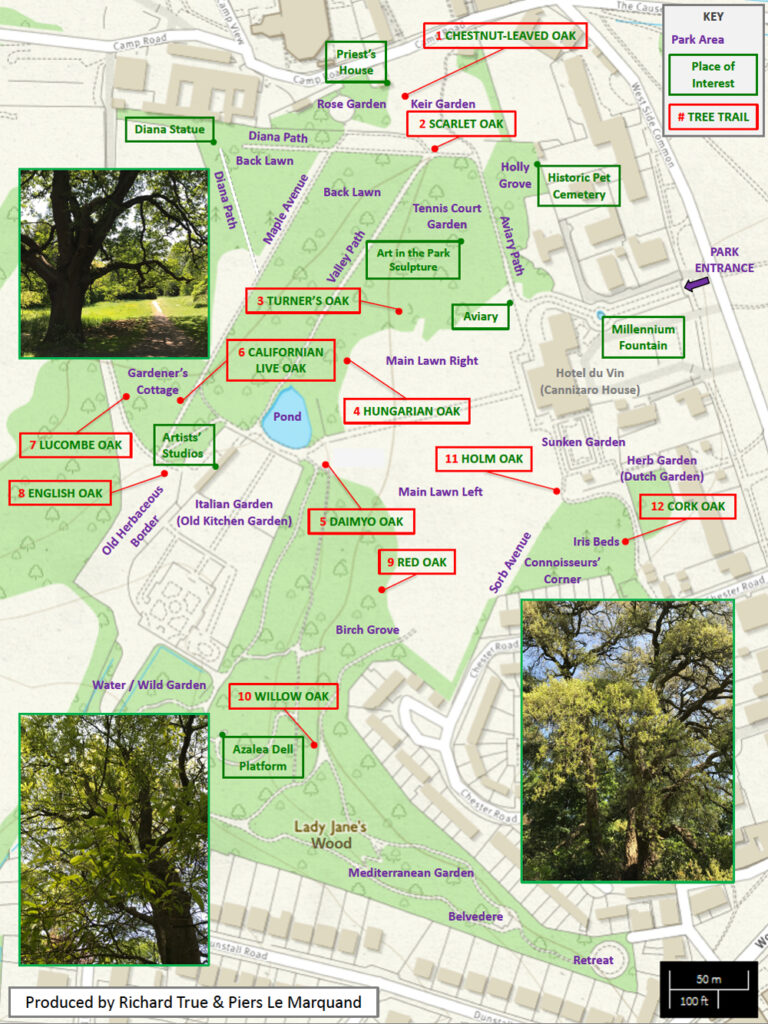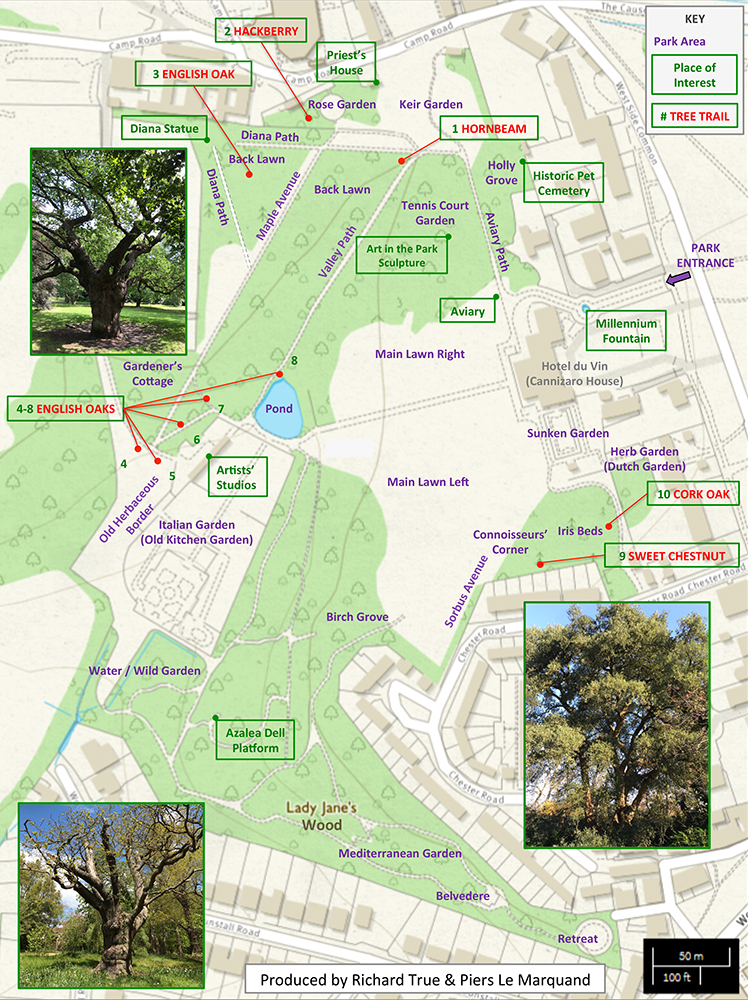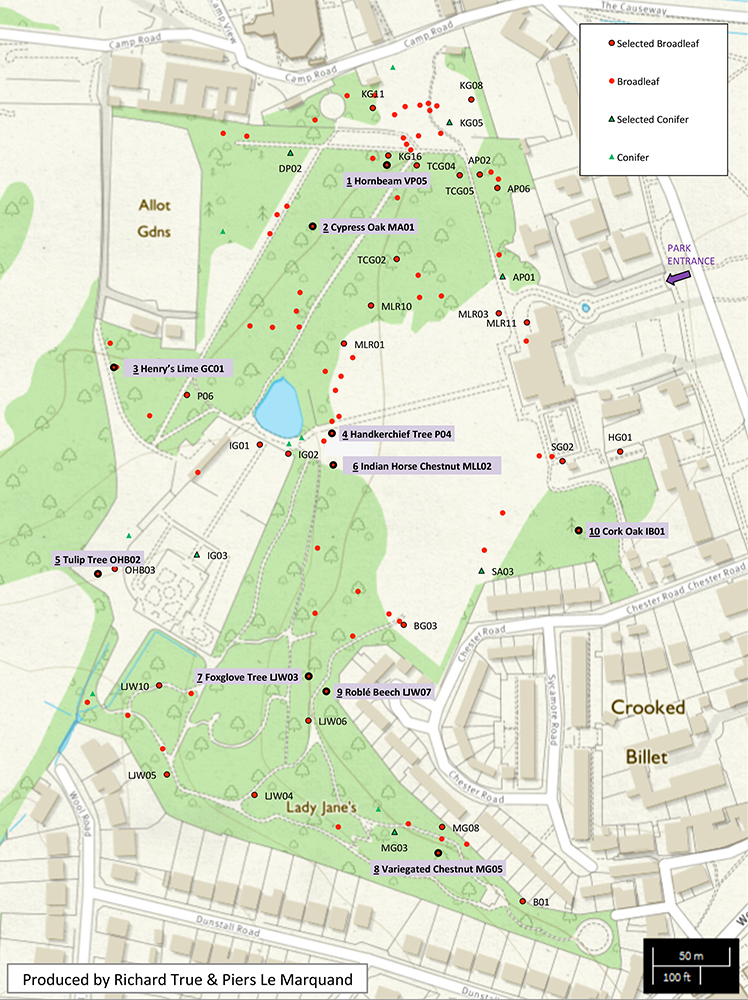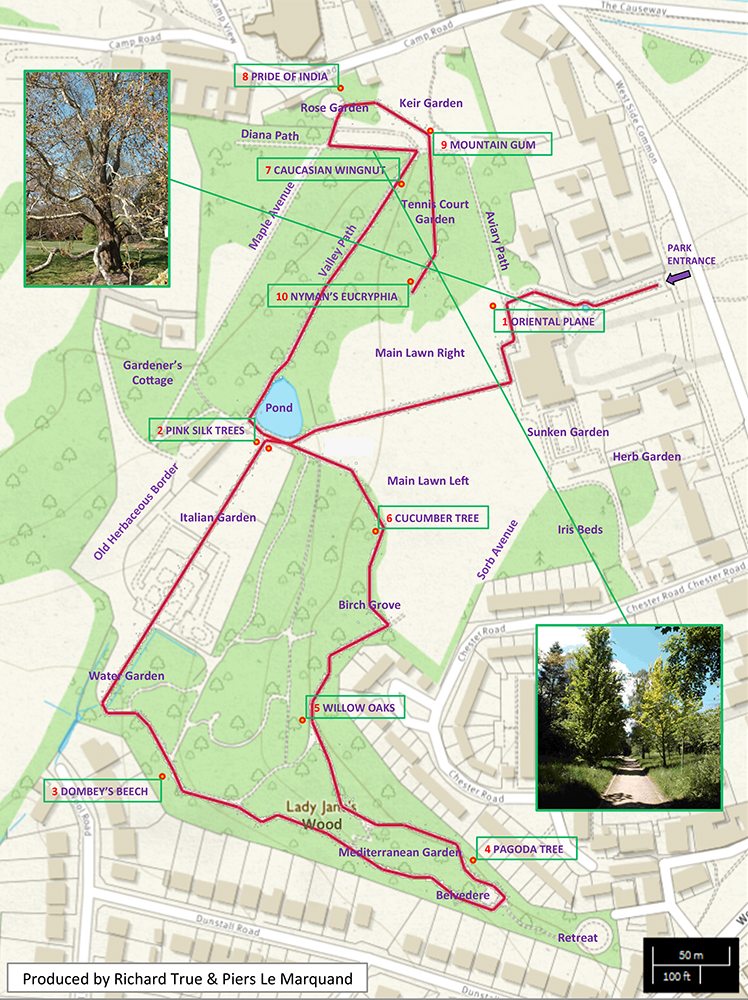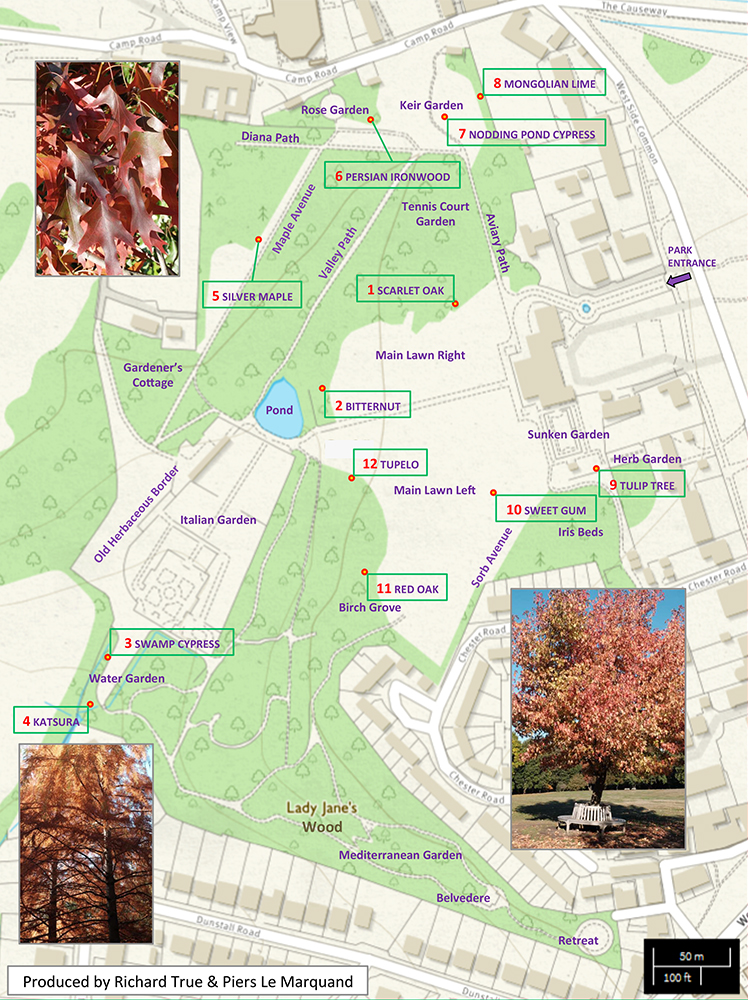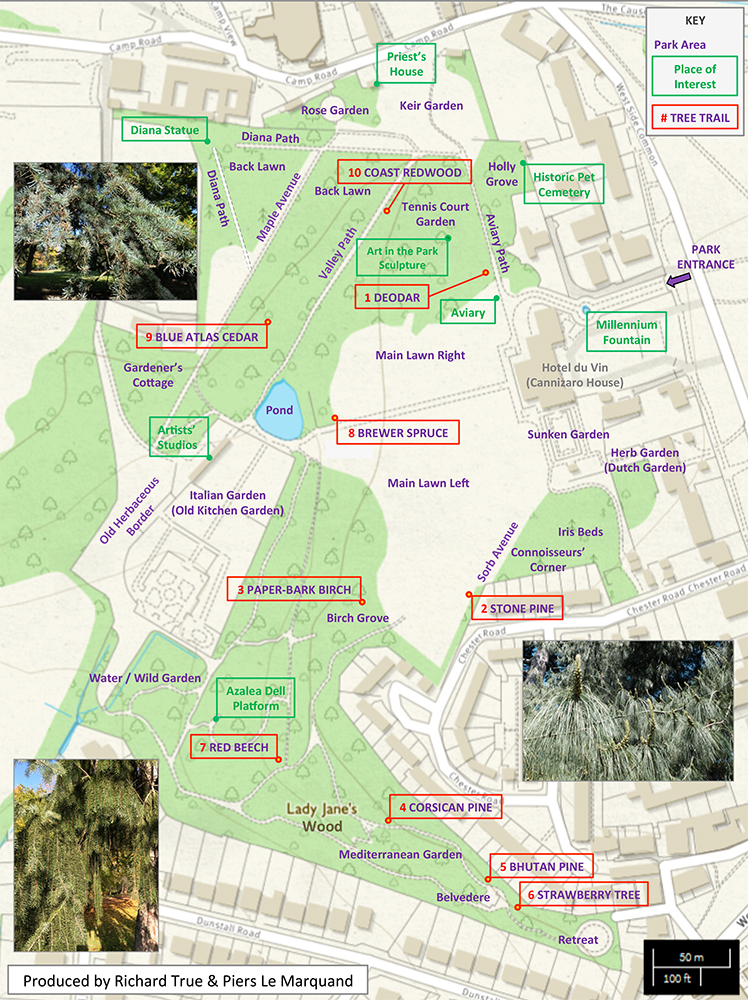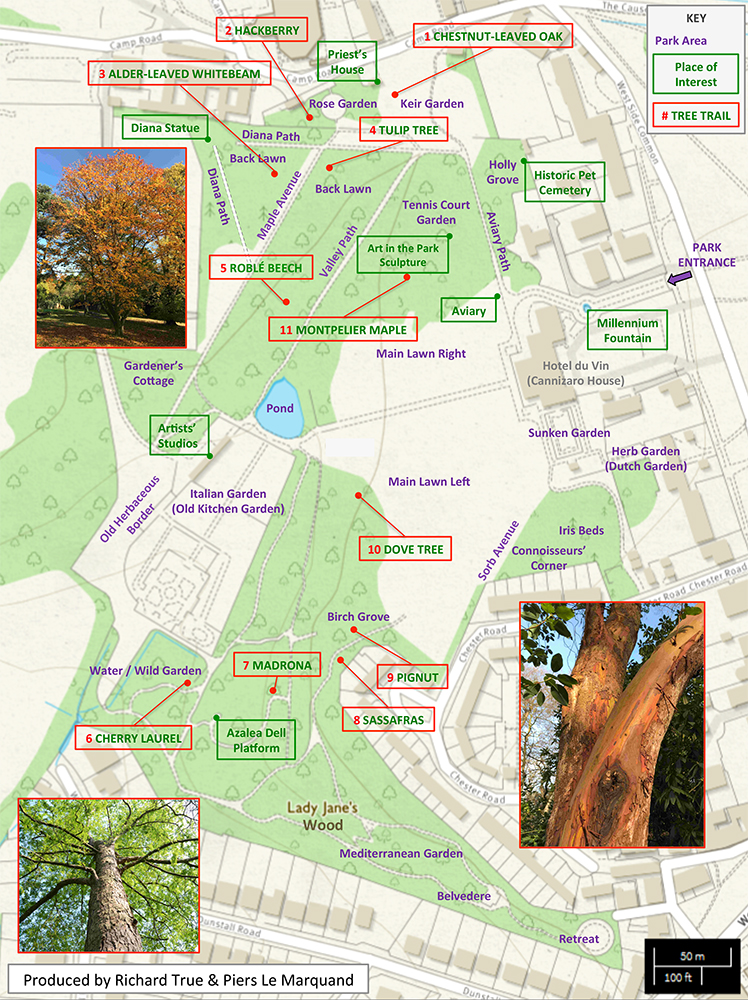Tree Collection
Welcome to the Tree Collection
In Cannizaro Park, we have one of the most diverse collections of trees in Greater London. There are over 200 species in the Park, and information about a selection of these is available here.
More than 30 trees in the Park have been recognised as ‘Champions’ for Greater London by The Tree Register of the British Isles (TROBI) in their extensive database, which means that they are the tallest and/or have the thickest trunks (largest girth) of their species. Two of these are of national significance:
Sassafras (Sassafras albidum)
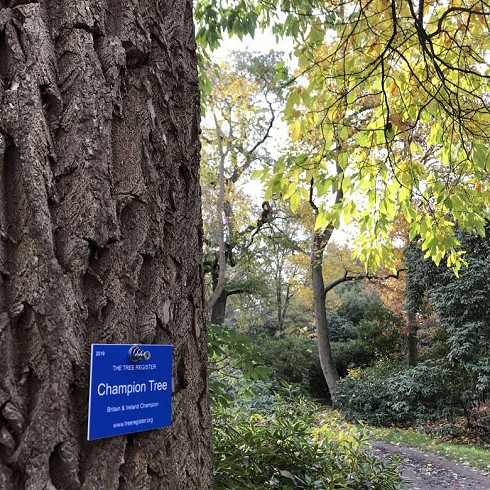
Located beside the path through Birch Grove. An England and British Isles Champion for its girth. It has therefore been ‘awarded’ a blue label by TROBI.
Alder-leaved Whitebeam (Sorbus alnifolia)
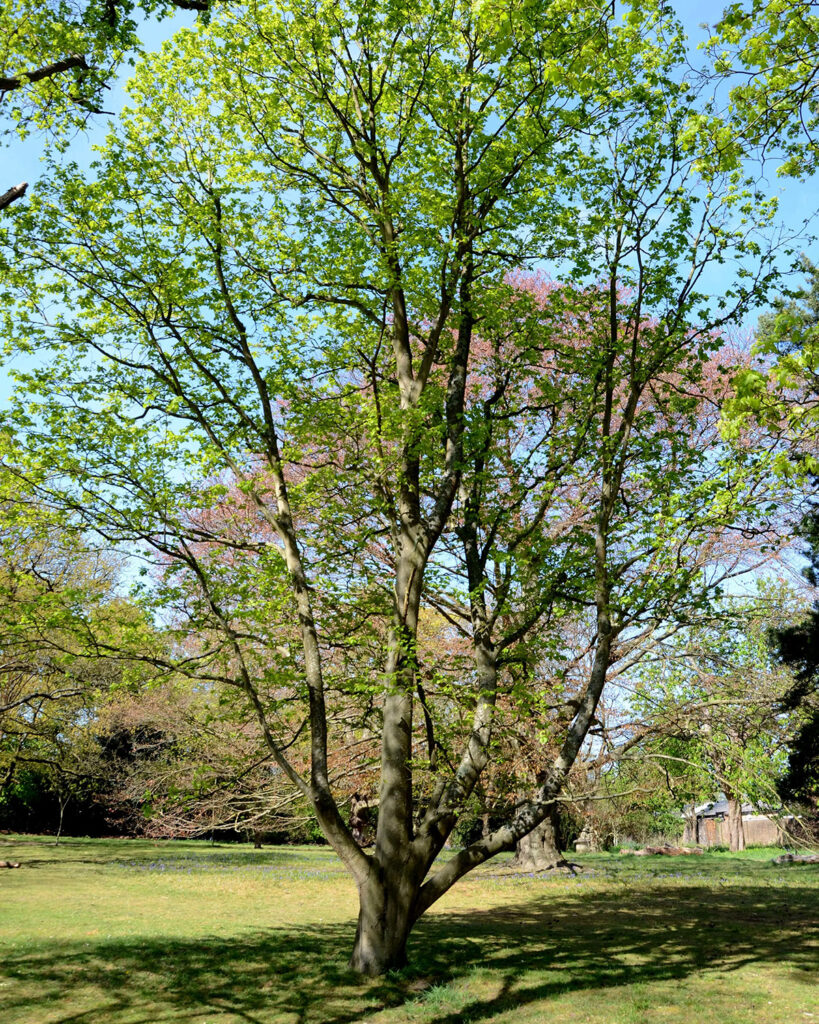
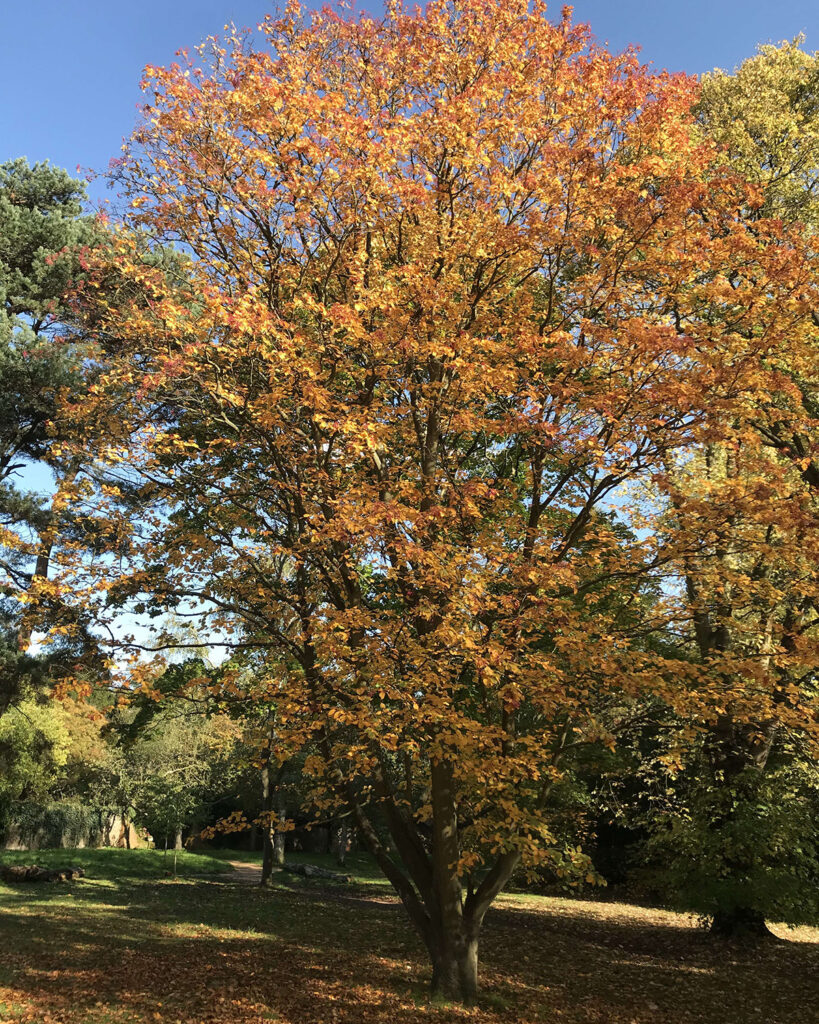
Near Maple Avenue on the Back Lawn. An England Champion for its height.
TROBI has also designated many of the Park’s trees as ‘Remarkable’ because they are significant examples of their species:
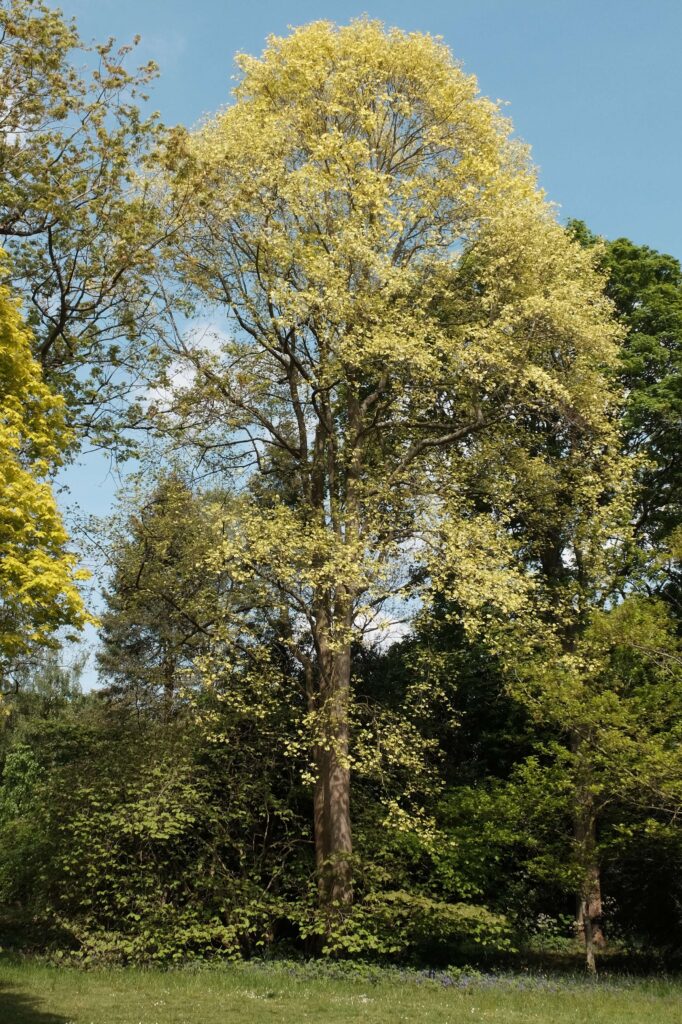
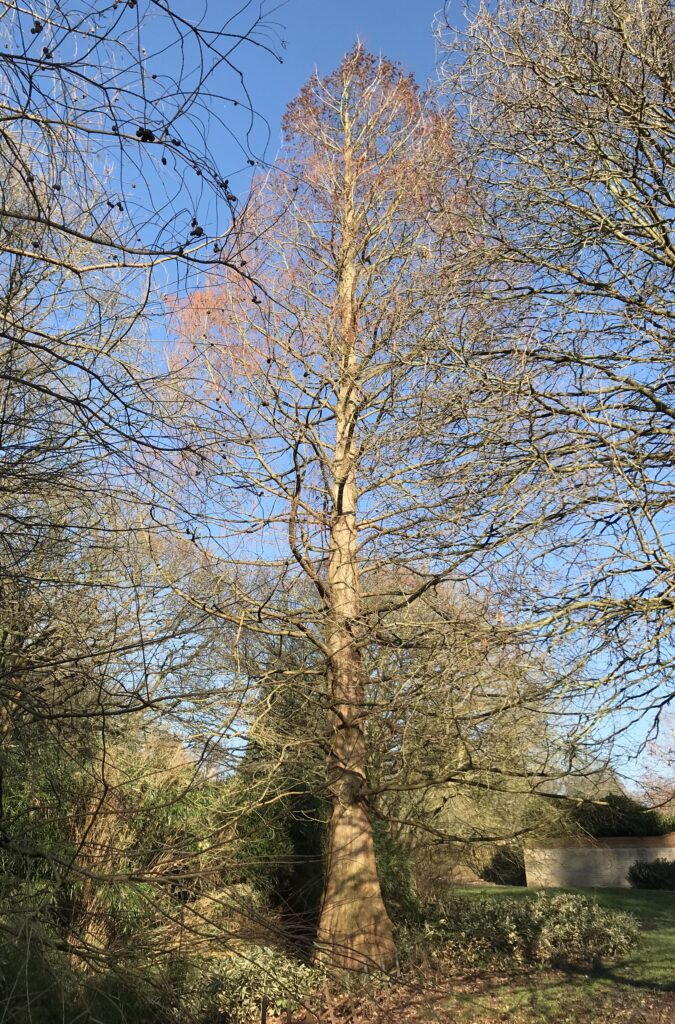
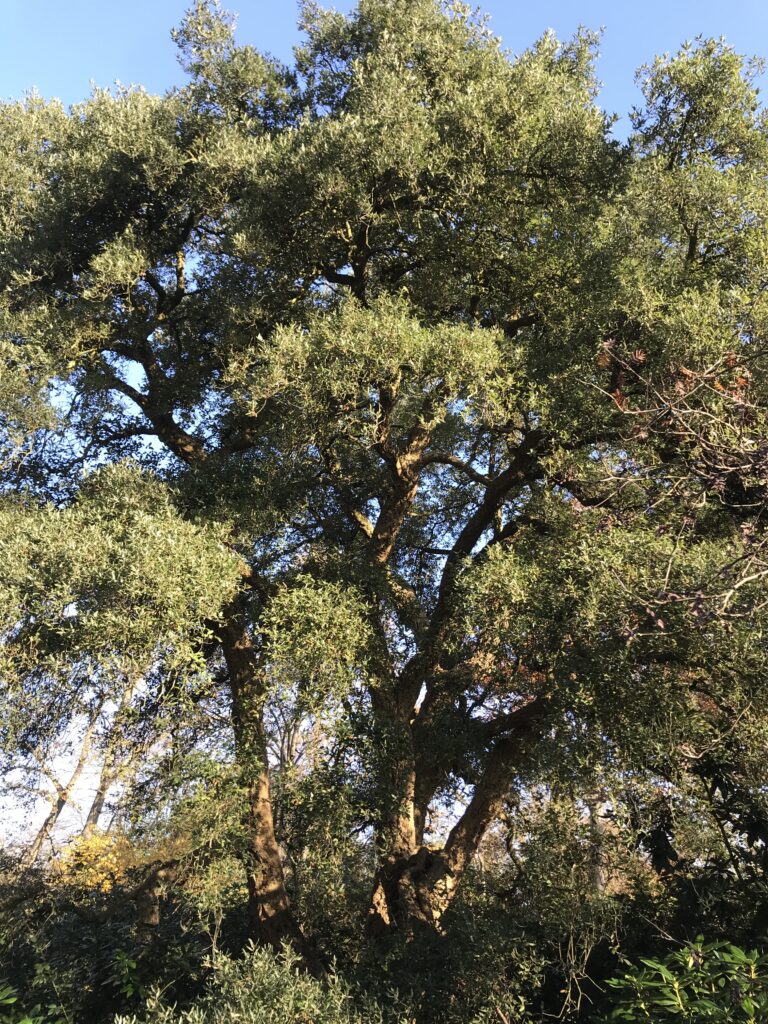
In addition, there are a number of trees noted as ‘Veterans’ by the Woodland Trust in their Ancient Tree Inventory (ATI), meaning that they have some of the features found on an ‘Ancient’ tree but are not so old. However, they may already show signs of decay, fungus, or dead wood and provide holes, cavities, and crevices, which are especially important for wildlife.
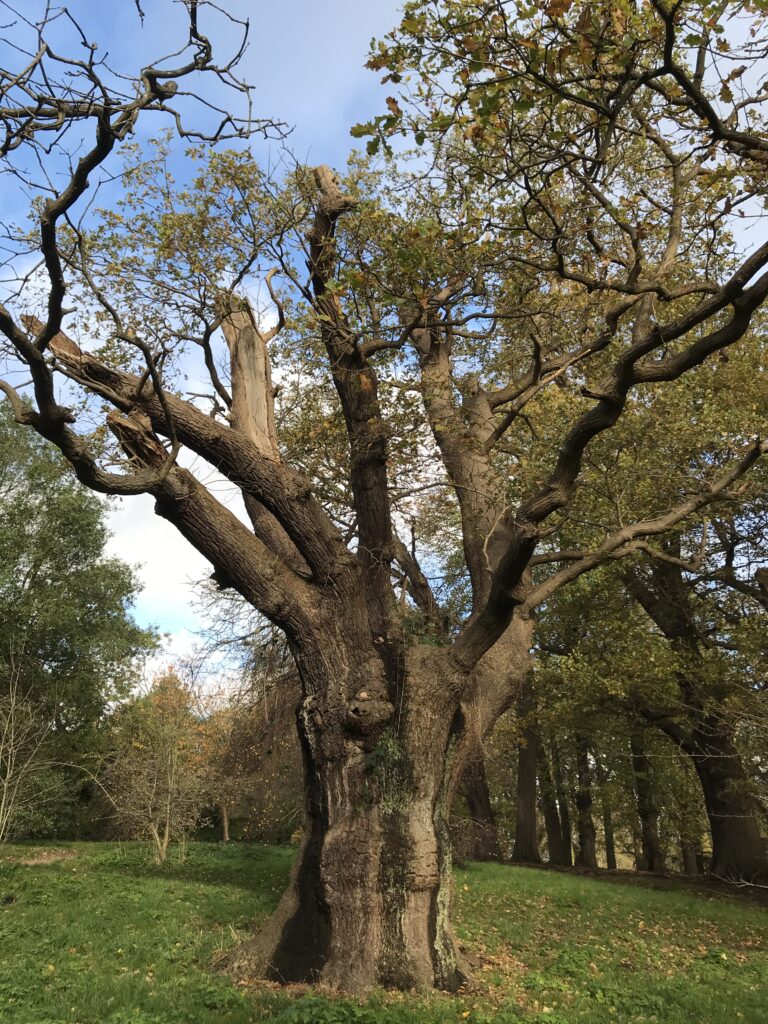
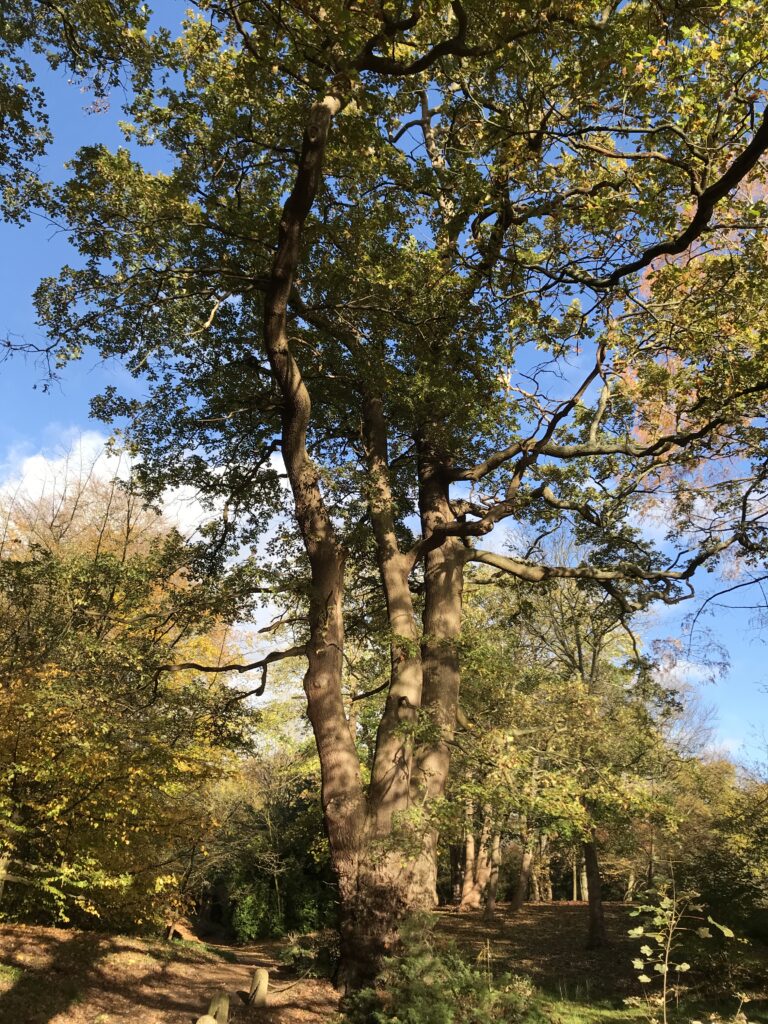
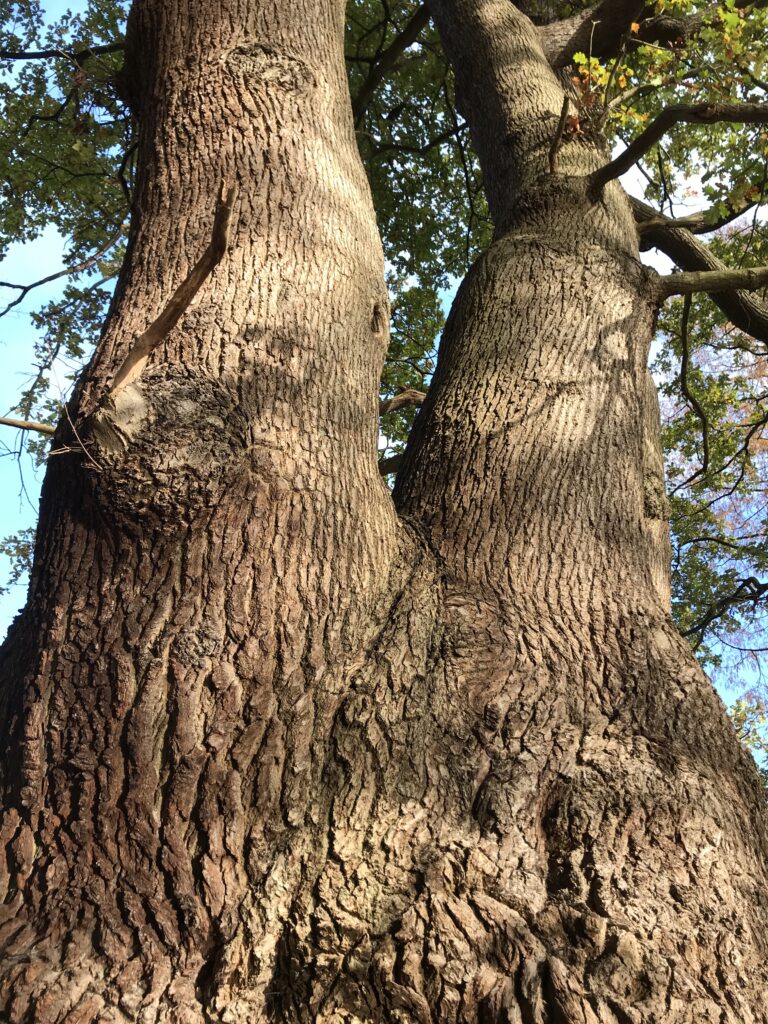
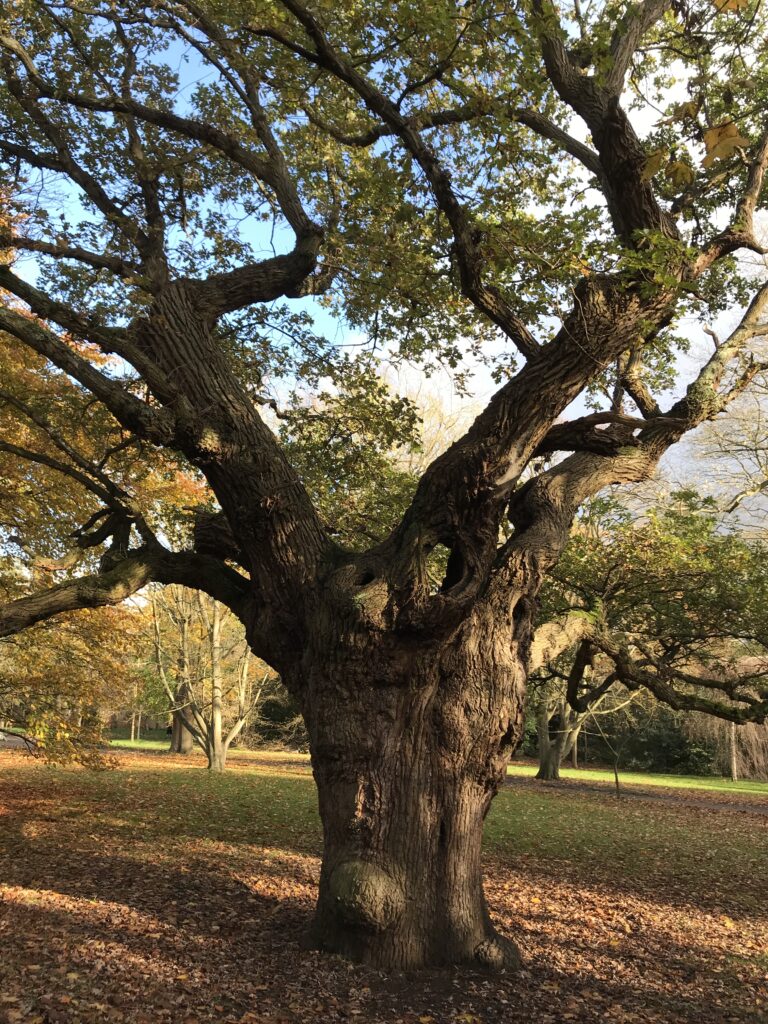
Tree Labels & Measurement
As part of the ‘Trees Project’, over 100 trees in the Park have already been labeled with their common and scientific name, together with a QR code containing more information about the tree, which can be read using a mobile phone QR code scanner app. Please note that if you try to use the iPhone camera QR code scanning function you will need to ‘swipe down’ the scan message and it will only show a limited amount of tree information text. For this reason, it is recommended that you download a dedicated app such as that available for free from Kaspersky. More labels will be put up over time.
Also, many of the Park’s Champion trees have been, and are being, re-measured to update the TROBI database.

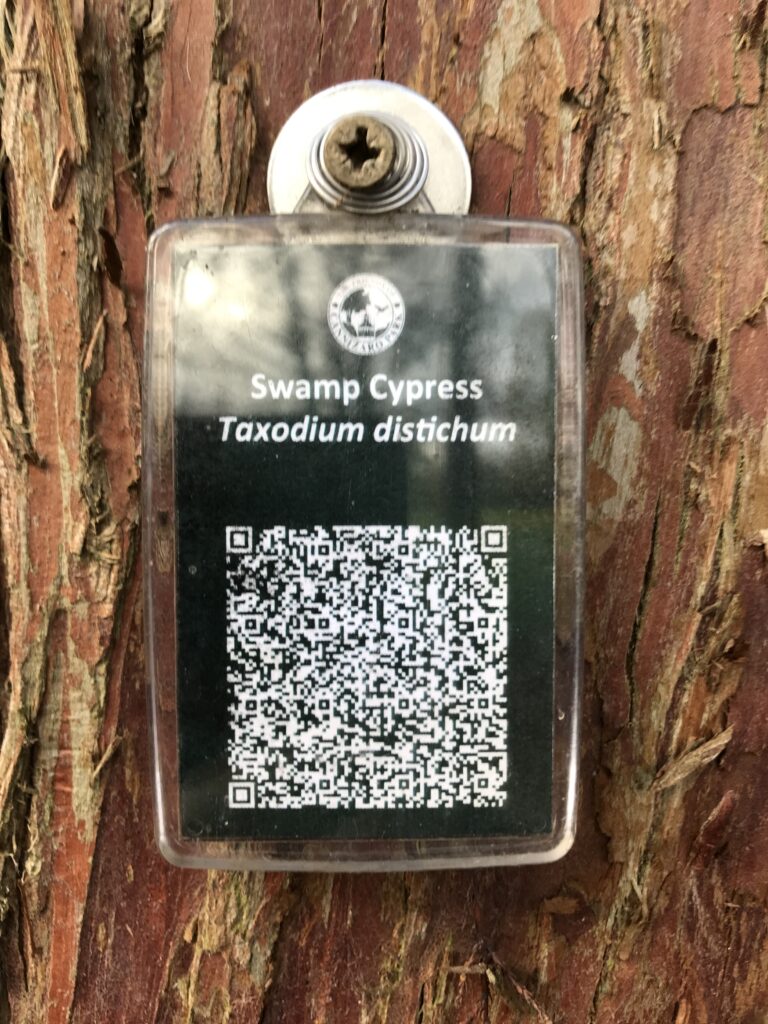
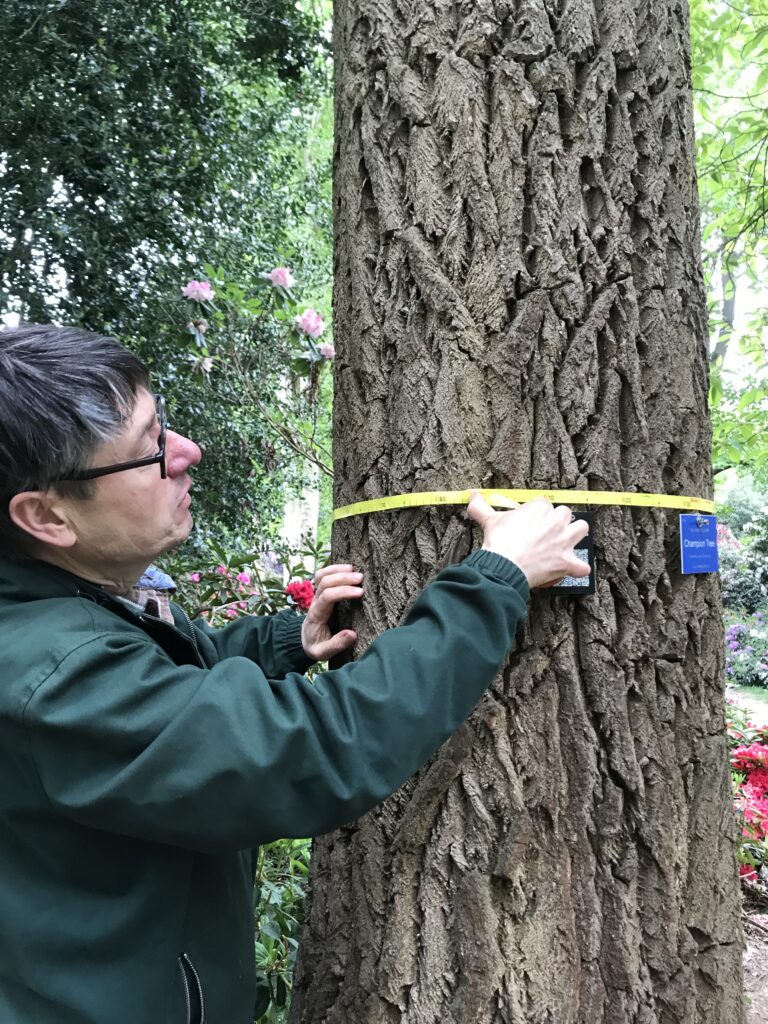
Tree Trail Maps
Tree trail maps have been produced and are available to download (see below). These include a Champions’ Trail, a Veterans’ Trail, and Seasonal Trails.
Tree Information
Information on the Tree Collection is organised by named location areas in the Park (see list below). Just click on a location, and you will discover the trees in that area. Then choose an individual tree to see its position on the satellite image, where the relevant tree icon will bounce. To find out the detailed information and see photos click the icon. You can also select the following special tree categories: Champion Trees, Remarkable Trees, and Veteran Trees.
Tree Planting
Every year, more trees are planted by the Park Volunteers to add to the collection.
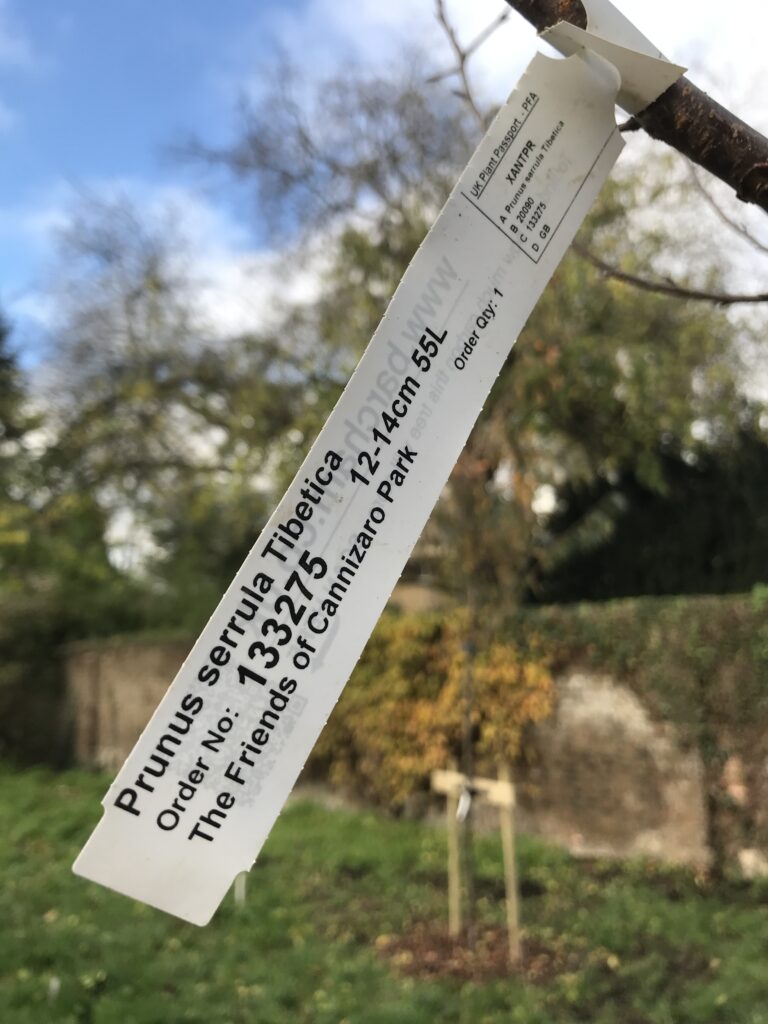
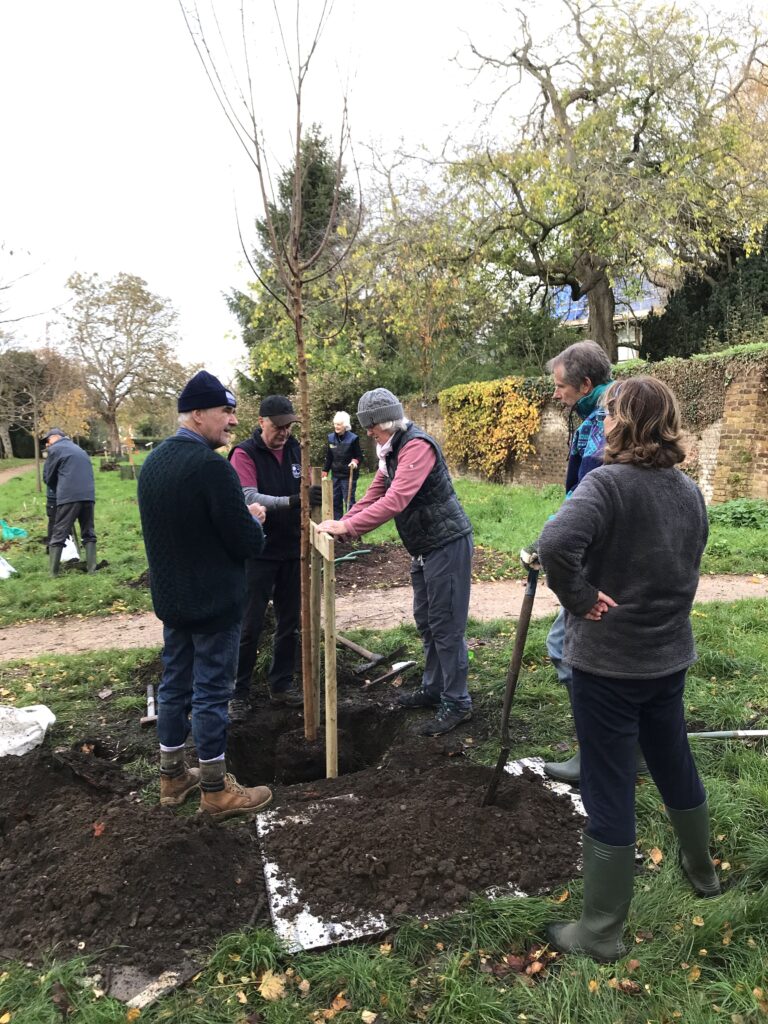
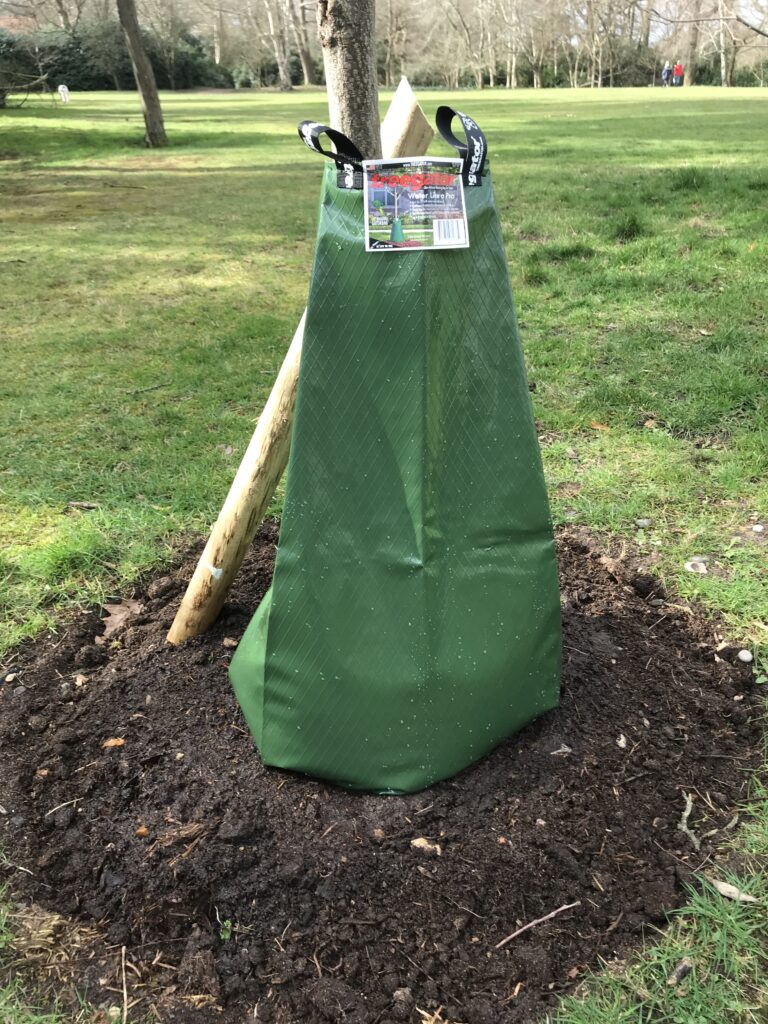
- Broadleaf
- Conifer
- Deciduous Conifer
- Evergreen Broadleaf
- Palm
Park Areas
Deodar
Cedrus deodara
Group: Conifer
Location: Aviary Path, AP01
True cedar with longer and softer leaves than others, such as the Blue Atlas (located in the Park near the Diana statue). A 19th century plan to grow it for shipbuilding in Britain failed because timber grown so far north lacked durability in sea water.
Natural range: W Himalayas
First introduced: 1831
Park tree information & images
Label type: QR code
Height: 19.8m (Jan 2020)
Girth: 360cm at height of 1.5m (Jan 2020)
Epaulette Tree
Pterostyrax hispida
Group: Broadleaf
Location: Aviary Path, AP02
Small broadleaf tree with simple large leaves and drooping, white and lemon-scented flowers in mid-summer. Very slender fruit covered in long pale-brown hairs, whose hanging plume remains until autumn.
Natural range: China & Japan
First introduced: 1875
Park tree information & images
Label type: QR code
Henry’s Lime
Tilia henryana
Group: Broadleaf
Location: Aviary Path, AP03
Broadleaf tree with leaves that have bristle-like teeth. Creamy-white flowers in summer. Named after Irish botanist Augustine Henry who discovered it in China in 1888. It was later introduced to the West by the plant collector and explorer Ernest ‘Chinese’ Wilson.
Natural range: China
First introduced: 1901
Park tree information & images
Label type: QR code
Hop Tree (Wafer Ash)
Ptelea trifoliata
Group: Broadleaf
Location: Aviary Path, AP06
Small broadleaf tree with leaves in threes, turning yellow in autumn and aromatic when crushed. Fragrant flowers in June and attractive circular-winged seeds in late summer. Despite its common names, it is unrelated to hops or ash.
Natural range: E North America
First introduced: 1704
Park tree information & images
Label type: QR code
Champion Tree
Nikko Maple
Acer maximowiczianum (A. nikoense)
Group: Broadleaf
Location: Aviary Path, AP05
Small broadleaf tree, rare outside natural range except in arboreta. Like other maples, it grows winged fruit (samaras) to spread its seed. Trifoliate leaves, having three leaflets, turn orange-red and yellow in autumn.
Natural range: Central China & Japan
First introduced: 1881
Park tree information & images
Label type: QR code
Height: 13.0m (May 2021)
Girth: 174cm at height of 0.2m (May 2021)
TROBI status: Height champion of Greater London (2021)
Strawberry Tree
Arbutus unedo
Group: Evergreen Broadleaf
Location: Belvedere, B01
Evergreen tree with attractive red-grey bark and strawberry-like fruits appearing in autumn. The Latin unedo means ‘I eat one only’ as the fruits do not taste good.
Natural range: Mediterranean & SW Ireland
First introduced: 16th century
Park tree information & images
Label type: QR code
Hardy Rubber Tree
Eucommia ulmoides
Group: Broadleaf
Location: Belvedere, B04
Broadleaf tree long cultivated in China for its bark and gum, which produces an alternative rubber material to the latex produced by the Rubber Tree, the tropical plant that is the main source of natural rubber.
Natural range: China (not now found in the wild)
First introduced: 1896
Park tree information & images
Label type: QR code
Champion Tree
Sassafras
Sassafras albidum
Group: Broadleaf
Location: Birch Grove, BG02
Broadleaf tree, which reproduces freely by suckers, sometimes appearing quite a distance from the main tree. In younger trees the leaves are three-lobed, but in older trees mostly single-lobed. Its root bark is used to make drinks.
Natural range: USA
First introduced: 16th century
Park tree information & images
Label type: QR code + TROBI
Height: 16.5m (Oct 2019)
Girth: 182cm at height of 1.5m (Oct 2019)
TROBI status: Girth champion of England & height champion of Greater London (2019)
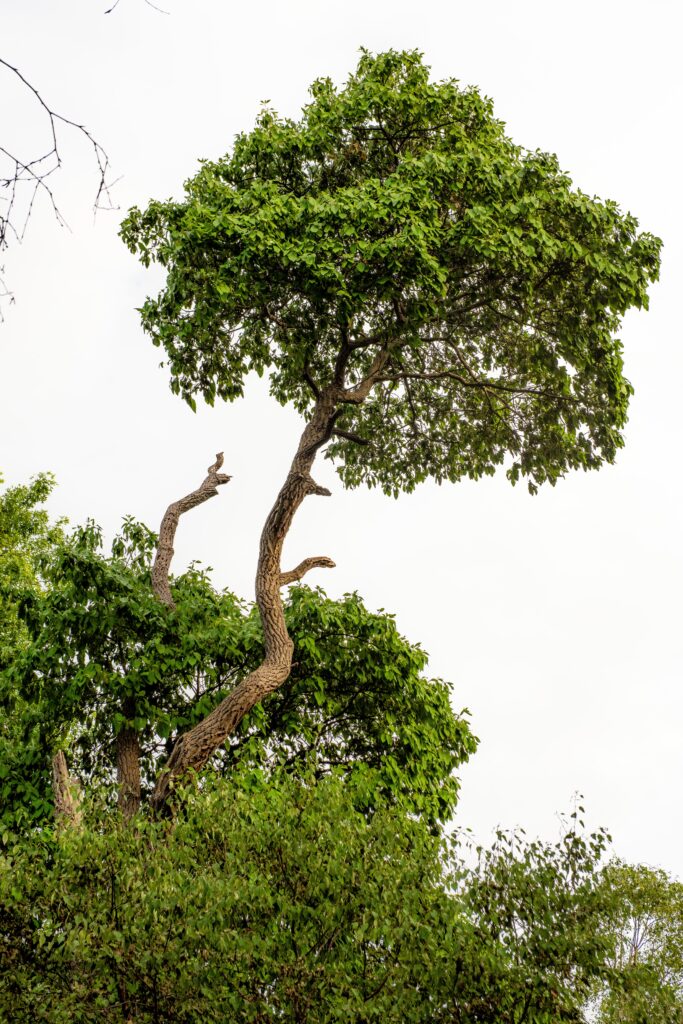
Maple-leaved Crab
Malus trilobata
Group: Broadleaf
Location: Birch Grove, BG03
Broadleaf tree named for its deeply three-lobed, maple-like leaves, which turn from orange to red to deep purple in autumn. White flowers in late spring are followed by small yellow fruits. Seeds contain the toxin hydrogen cyanide.
Natural range: E Mediterranean & NE Greece
First introduced: 1877
Park tree information & images
Label type: QR code
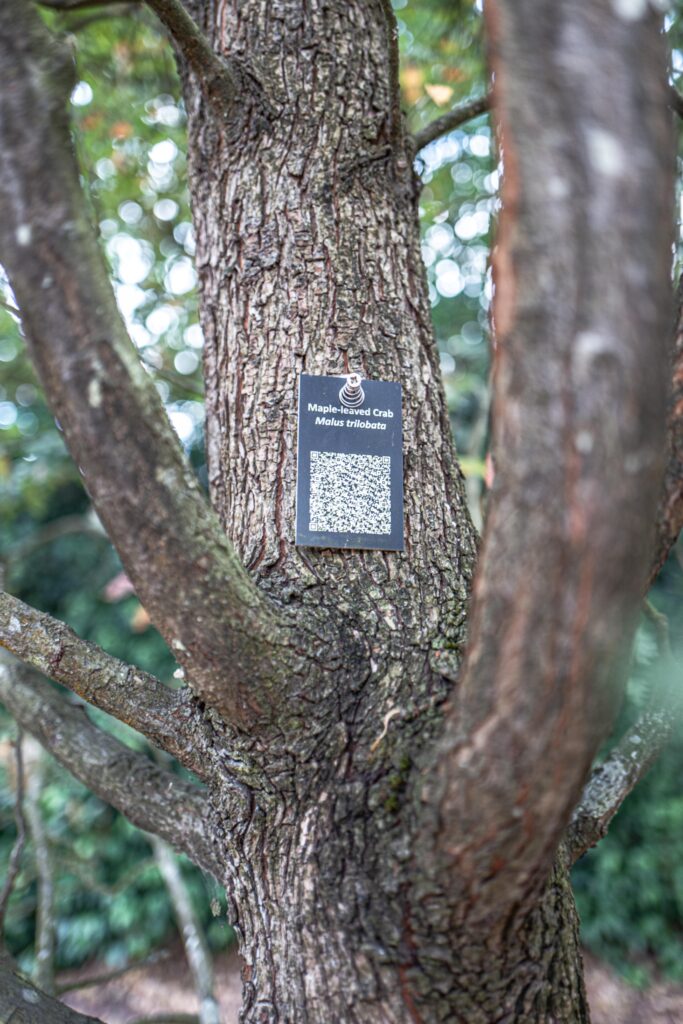
Champion Tree
Pignut (Smoothbark Hickory)
Carya glabra
Group: Broadleaf
Location: Birch Grove, BG07
Broadleaf tree, one of the hickories, with large leaves turning yellow in autumn. Related to the Pecan, but the nuts are inedible. The Bitternut is another hickory in the Park, on the edge of the Main Lawn above the Pond.
Natural range: North America, Ontario to E Texas
First introduced: c.1750
Park tree information & images
Label type: QR code
Height: 25.5m (Oct 2019)
Girth: Twin trunk - 172cm at height of 1.5m (Oct 2019)
TROBI status: Height champion of Greater London (2019)
Remarkable Tree
Yunnan Crab
Malus yunnanensis
Group: Broadleaf
Location: Birch Grove, BG08
Rare broadleaf tree with sweet-scented spring flowers and small red crab apples with white dots in autumn. This one in the Park is noted by The Tree Register as being remarkable.
Natural range: W China
First introduced: 1908
Park tree information & images
Label type: QR code
Height: 11.0m (Oct 2019)
Girth: 94cm at height of 0.9m (Oct 2019)
TROBI status: Remarkable tree of Greater London (2019)
Paper-bark Birch (Canoe Birch)
Betula papyrifera
Group: Broadleaf
Location: Birch Grove, BG05
Broadleaf tree with bark that peels horizontally in thin layers and is generally whiter than the Silver Birch. Gets one of its names because the bark was used by Native Americans to make canoes.
Natural range: North America
First introduced: 1750
Park tree information & images
Label type: QR code
Scots Pine
Pinus sylvestris
Group: Conifer
Location: Diana Paths, DP02
Tall conifer with pine needles in pairs. It can live up to 700 years. Birch and Scots Pine were the first trees in Britain after the last ice age. Some natural forests of Scots Pine remain in the Scottish Highlands.
Natural range: Europe including Britain.
Park tree information & images
Label type: QR code
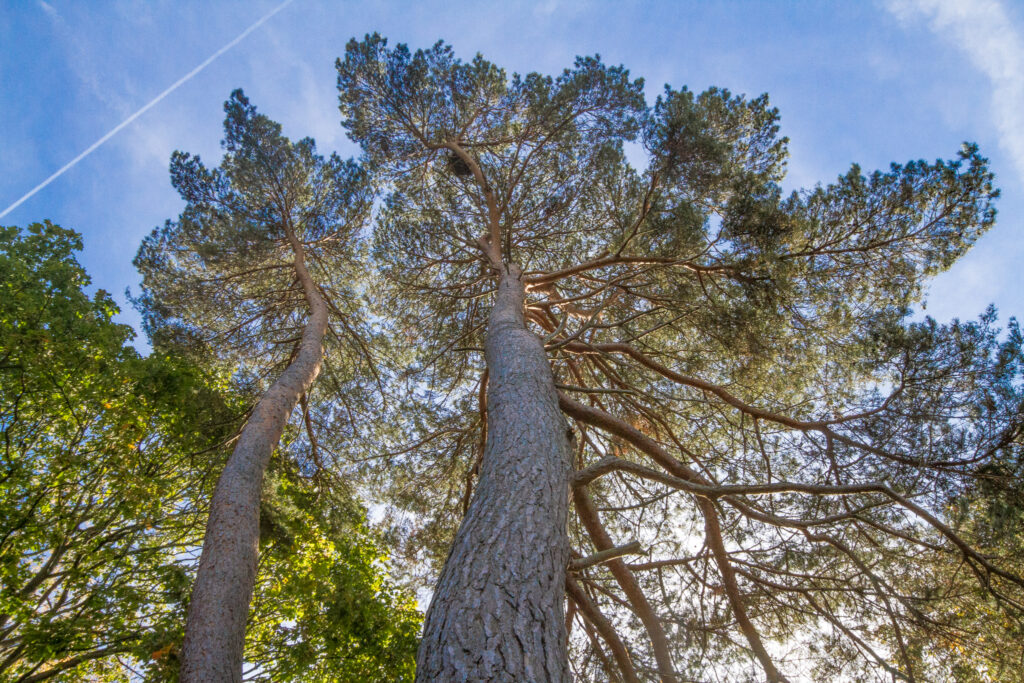
Champion Tree
Alder-leaved Whitebeam
Sorbus alnifolia
Group: Broadleaf
Location: Diana Paths, DP06
Broadleaf tree with attractive white flowers in spring and small orange berries in autumn/winter. Name is misleading as the leaves look more like a hornbeam’s. In 2020 this tree was listed by The Tree Register as the tallest of its species in England.
Natural range: E Asia
First introduced: 1892
Park tree information & images
Label type: QR code
Height: 14.5m (Feb 2020)
Girth: 161cm at height of 0.3m (Feb 2020)
TROBI status: Height champion of England (2020)
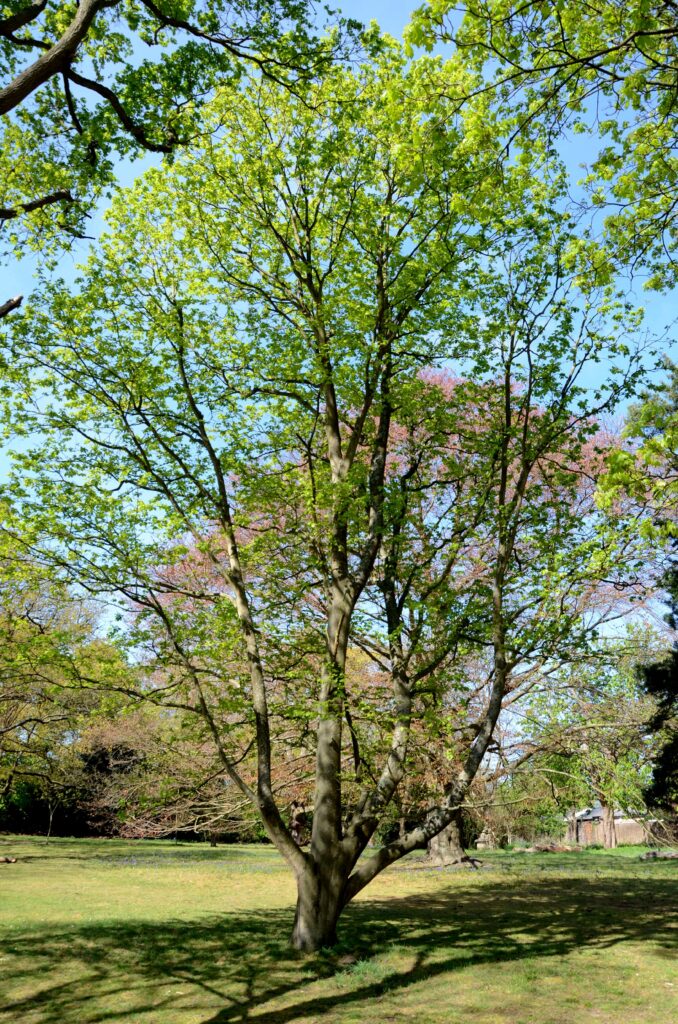
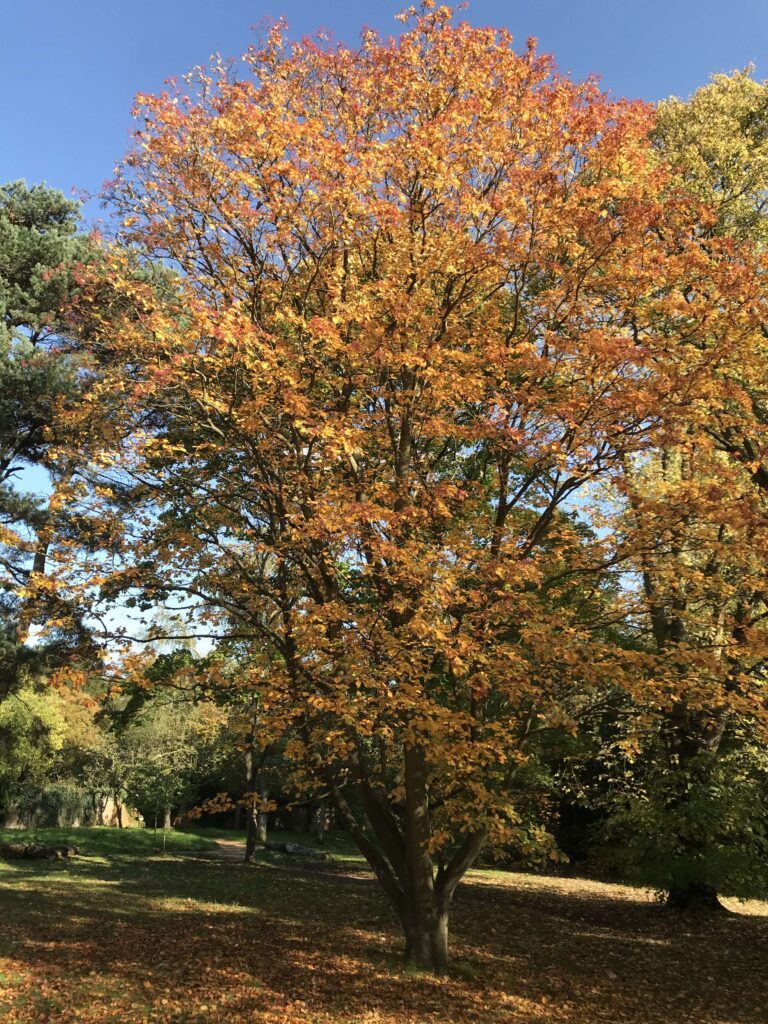
Veteran Tree
English Oak (Pedunculate Oak) - DP13
Quercus robur
Group: Broadleaf
Location: Diana Paths, DP13
Veteran pollard.
Park tree information & images
Label type: None
Girth: 398cm at height of 0.9m (2011)

Manna Ash
Fraxinus ornus
Group: Broadleaf
Location: Diana Paths, DP07
Broadleaf tree with decorative late spring flowers. A sugary extract of its sap was compared in late medieval times to the biblical manna, hence its common name. It has smooth, dark-grey bark, finely serrated leaves with pairs of leaflets (pinnate) and winged fruit (samsara).
Natural range: S Europe & SW Asia
Park tree information & images
Label type: QR code
Silver Maple
Acer saccharinum
Group: Broadleaf
Location: Diana Paths, DP10
Broadleaf tree with small red flowers in early spring. Deeply lobed, palm-like leaves, which are bright silver-grey underneath, giving it its common name. Good red and yellow colour in autumn.
Natural range: North America, Quebec to Florida
First introduced: 1725
Park tree information & images
Label type: QR code
Euodia
Tetradium daniellii
Group: Broadleaf
Location: Diana Paths, DP08
Broadleaf tree with frothy white flower heads in summer followed by clusters of crimson berries. Species is named after W. Daniell, a British surgeon in China, who collected the leaves. However, it was introduced by Ernest Wilson, who brought many Chinese species to Britain.
Natural range: China & Korea
First introduced: 1907
Park tree information & images
Label type: QR code
Copper Beech
Fagus sylvatica f. purpurea
Group: Broadleaf
Location: Diana Paths, DP09
Cultivated form of the Common Beech, but can also appear in the wild as a natural mutant. Leaves are purple in spring, turning copper in autumn.
Natural range: Europe (Common Beech)
Park tree information & images
Label type: QR code
Honey Locust
Gleditsia triacanthos
Group: Broadleaf
Location: Gardener's Cottage, GC04
Broadleaf tree with strongly scented, cream flowers in late spring. Seed pods are protected from animals by thorns growing out of the branches. The name comes from the sweet taste of the seed pod pulp, which was used by Native Americans for tea.
Natural range: Central North America
First introduced: 1700
Park tree information & images
Label type: QR code
Small-leaved (Box-leaf) Azara
Azara microphylla
Group: Evergreen Broadleaf
Location: Herb Garden, HG01
Small evergreen broadleaf tree with cascading stems densely strung with small, shining, dark green leaves on a herringbone arrangement of branches. Little, vanilla/chocolate-scented clusters of fluffy yellow petal-less flowers in late winter.
Natural range: S Central Andes
First introduced: c1861
Park tree information & images
Label type: QR code
Height: 5.0m (Feb 2020)
Girth: 57cm at height of 1.5m (Feb 2020)
Remarkable Tree
Cork Oak
Quercus suber
Group: Evergreen Broadleaf
Location: Iris Beds, IB01
Evergreen Oak, which is slower-growing and shorter-lived than many Oaks. Spikes of greenish flowers in June. Named for its thick corky bark, which helps withstand forest fires. Main source of cork for wine bottle stoppers and core of cricket balls.
Natural range: SW Europe & NW Africa
Park tree information & images
Label type: QR code
Girth: 276cm at height of 0.4m (2021)
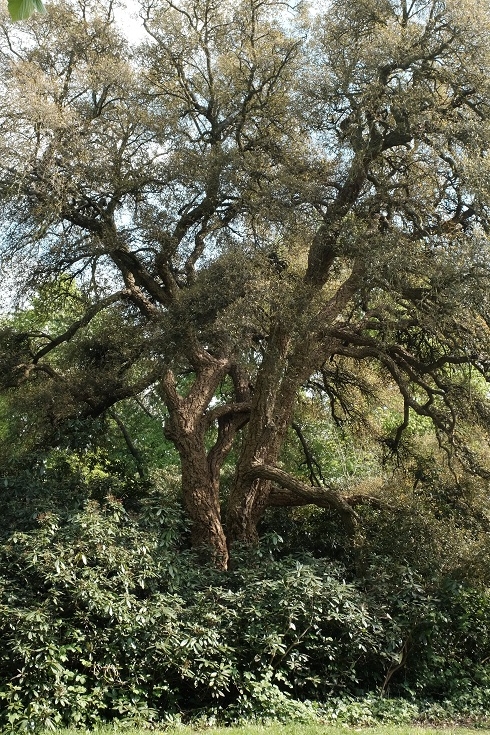
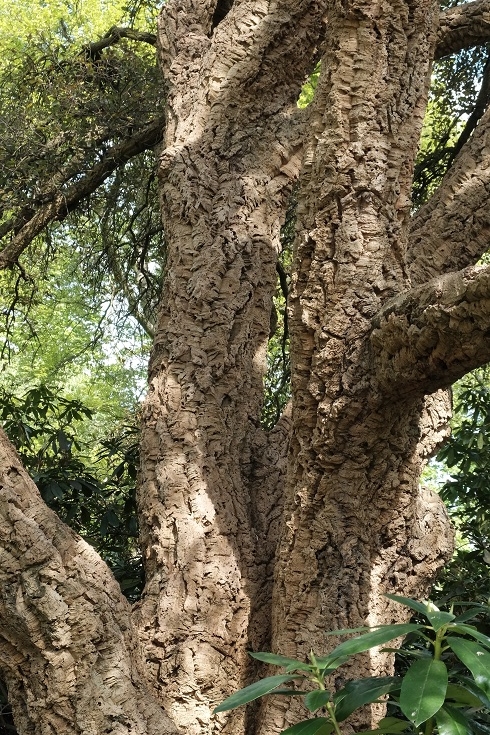
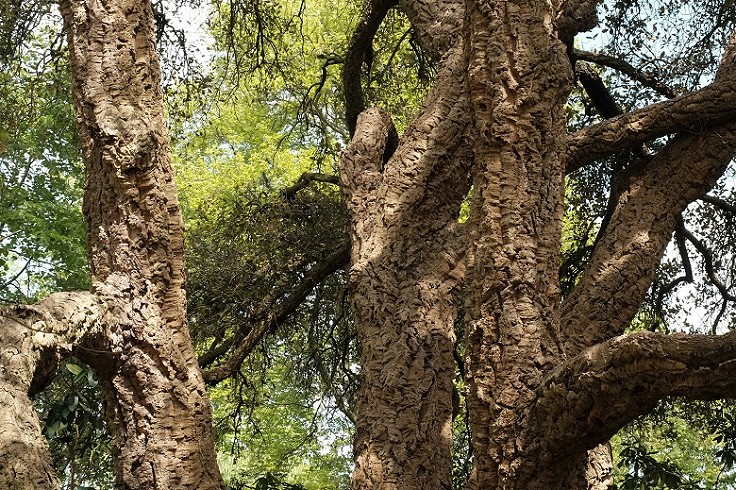
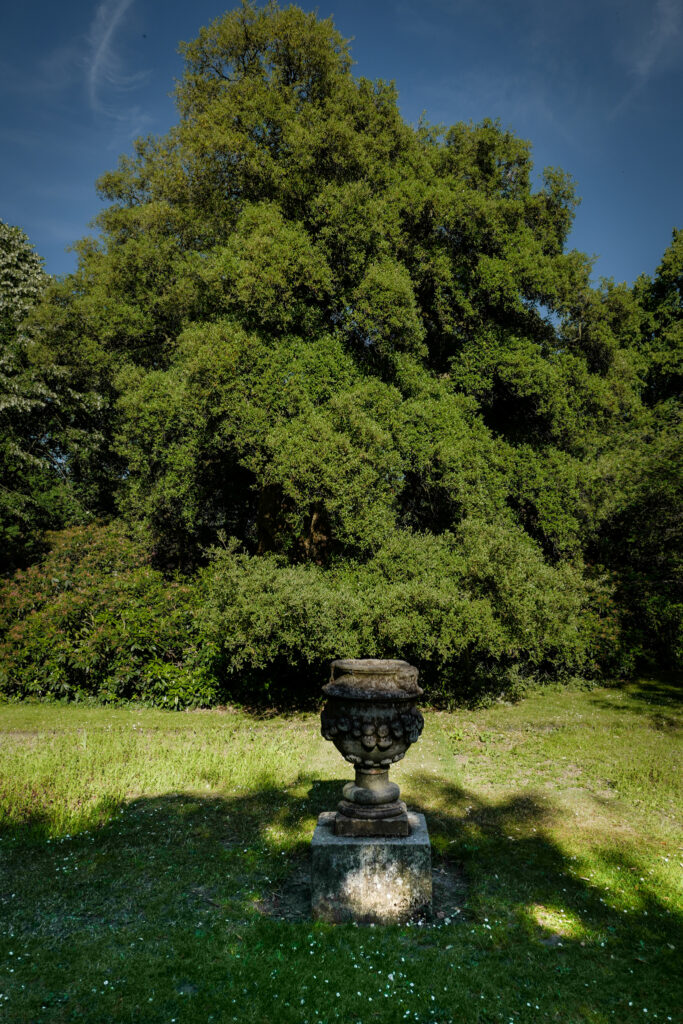
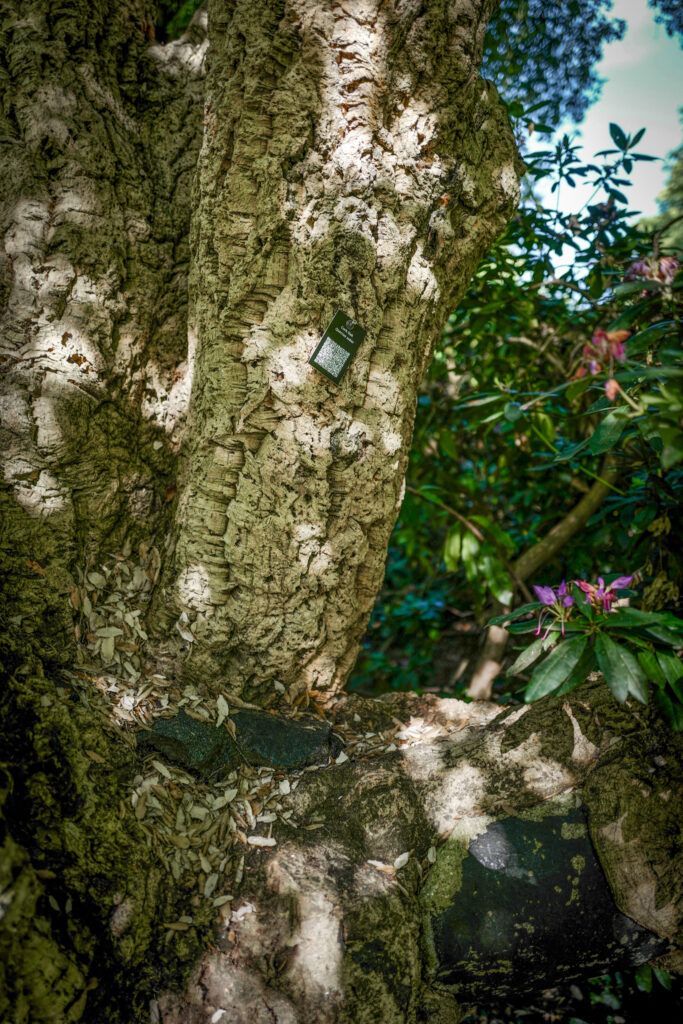
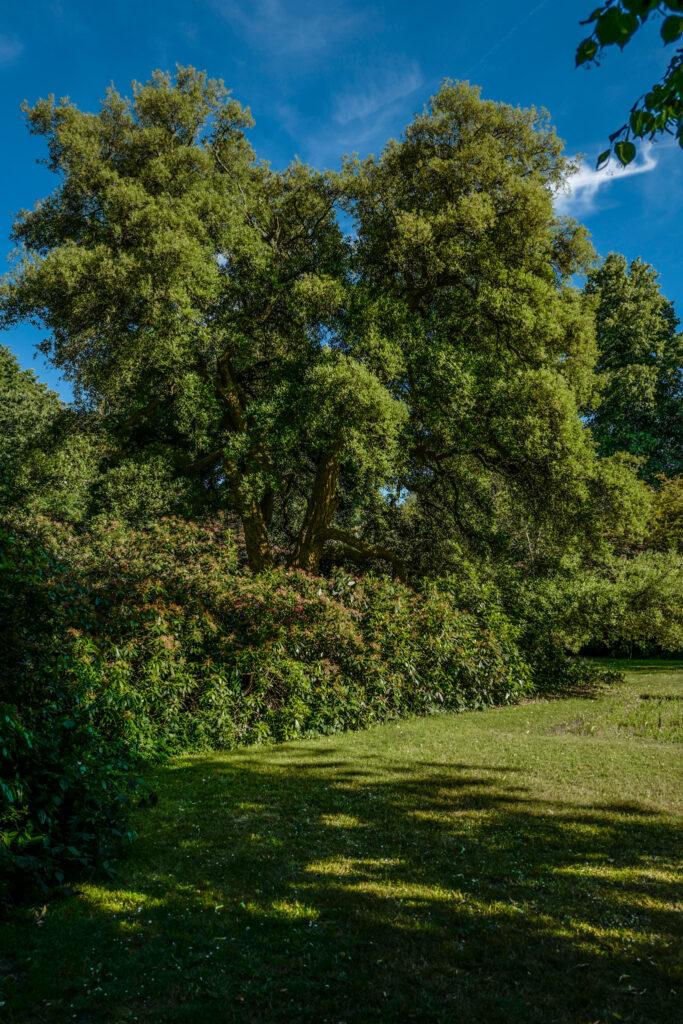
Pink Siris (Silk Tree)
Albizia julibrissin f. rosea
Group: Broadleaf
Location: Italian Garden, IG01
Broadleaf tree from Mimosa family. Attractive leaflets, which are bipinnate (divided into smaller leaflets) and fold when touched or at night. Fluffy, fragrant rose-pink flowers with prominent stamens in summer.
Natural range: Ethiopia, Iran-Japan, China.
First introduced: 1745
Park tree information & images
Label type: QR code
Height: 6.5m (Feb 2020)
Girth: 53cm at height of 1.5m (Feb 2020)
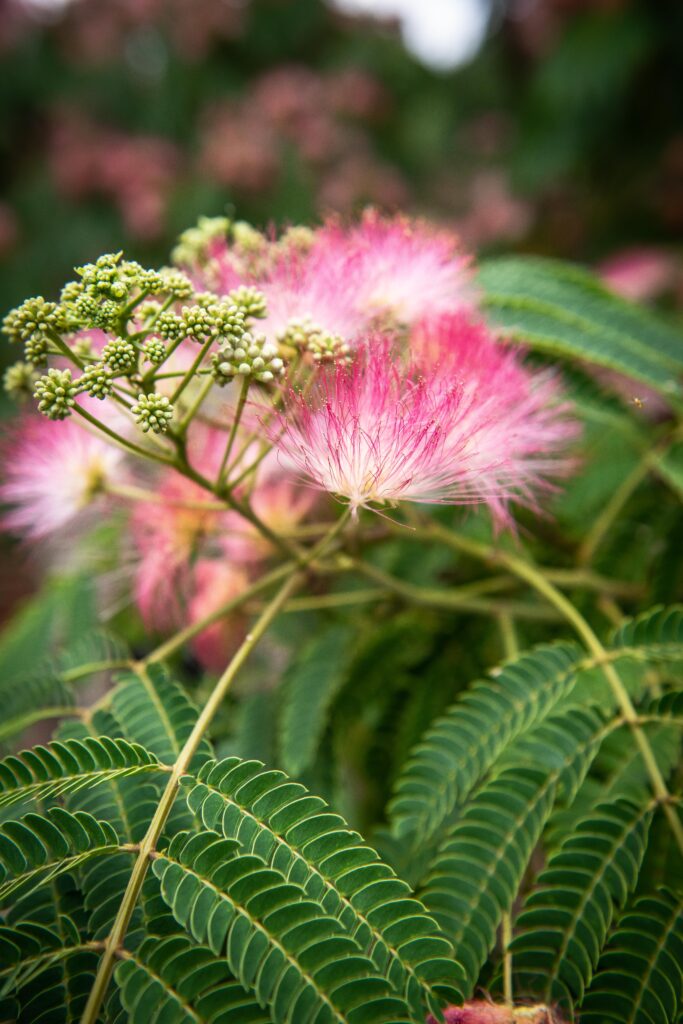
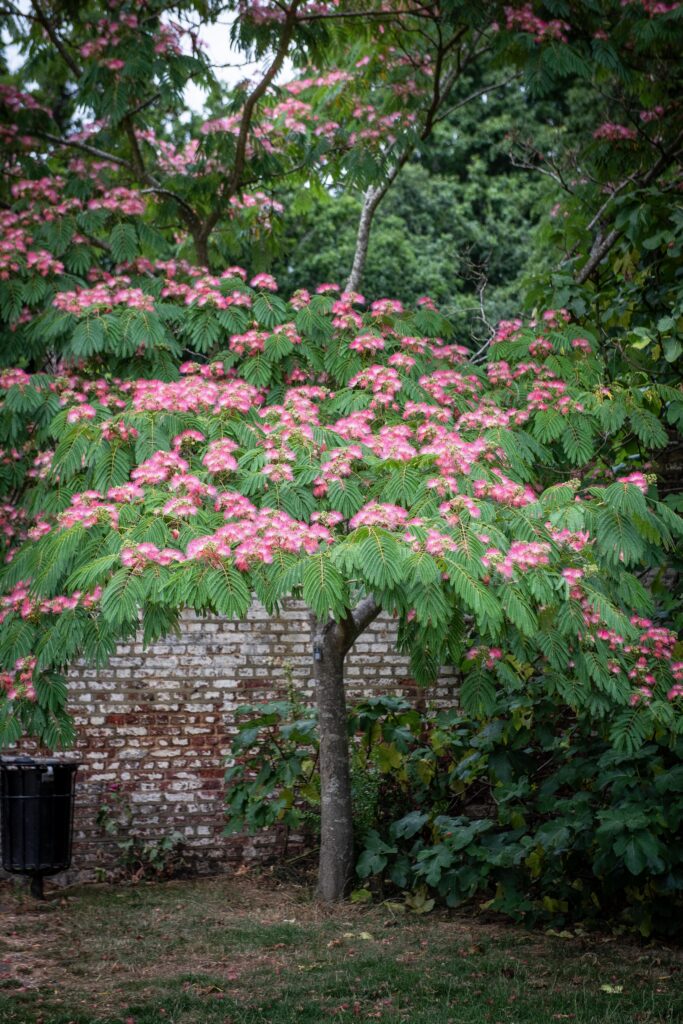
Paper Mulberry
Broussonetia papyrifera
Group: Broadleaf
Location: Italian Garden, IG02
Broadleaf tree with leaves usually varying from a heart-shaped norm. Catkins/greenish flowers in spring, whose pollen can cause allergies. Orange-red, woody, inedible fruit. Grown in China and Japan for its fibrous bark, used to make paper and cloth.
Natural range: Asia
Park tree information & images
Label type: QR code
Remarkable Tree
Dawn Redwood (Water Fir)
Metasequoia glyptostroboides
Group: Deciduous Conifer
Location: Water / Wild Garden, WG02
Deciduous conifer, which was only discovered in 1941. Its trunk forms a distinctive ‘armpit’ to support each branch. Faces extinction in the wild. A living fossil species, which existed in the Mesozoic Era. Cones appear only in regions with hot summers.
Natural range: SW China
Park tree information & images
Label type: QR code
Height: 26.4m (Jan 2020)
Girth: 354cm at height of 1.5m (Jan 2020)
TROBI status: Remarkable tree of Greater London (2020)

Yellow-wood
Cladrastis kentukea
Group: Broadleaf
Location: Italian Garden, IG08
Broadleaf tree with attractive large matt-green leaves, staggered along a common stalk, showing good autumn colour. Named after the yellow dye that comes from its wood. Does not reliably flower in the British climate.
Natural range: Indiana to Carolina, USA
First introduced: 1812
Park tree information & images
Label type: QR code
Buckeye hybrid
Aesculus x bushii
Group: Broadleaf
Location: Italian Garden, IG05
Hybrid buckeye produced from Red Buckeye and Ohio Buckeye parents. The flowering candles are large and colourful. The parent plants are from East USA where this hybrid can appear naturally. Buckeyes are North American horse chestnuts, named because of the conker’s resemblance to a deer’s eye.
Park tree information & images
Label type: QR code
White Mulberry
Morus alba
Group: Broadleaf
Location: Italian Garden, IG10
Broadleaf tree cultivated in Europe for many centuries. Silkworms feed on the leaves and the trees may have been planted in England as early as the Middle Ages for silk production. Whitish pink fruit differs from Black Mulberry’s, which is reddish purple.
Natural range: China
Park tree information & images
Label type: QR code
Champion Tree
Chestnut-leaved Oak
Quercus castaneifolia ‘Greenspire’
Group: Broadleaf
Location: Keir Garden, KG20
Broadleaf tree whose name describes the shape of its leaves, like a Sweet Chestnut’s. This variant is grown for its more columnar shape, with its branches pointing up, but as the Park specimen has matured it has broadened out.
Natural range: Caucasus, Iran
First introduced: 1846
Park tree information & images
Label type: QR code
Height: 21.0m (Feb 2020)
Girth: 221cm at height of 1.0m (Feb 2020)
TROBI status: Girth & height champion of Greater London (2020)
Chinese Tupelo
Nyssa sinensis
Group: Broadleaf
Location: Keir Garden, KG08
Broadleaf tree with oval-shaped leaves turning an intense yellow and red colour in autumn.
Park tree information & images
Label type: QR code
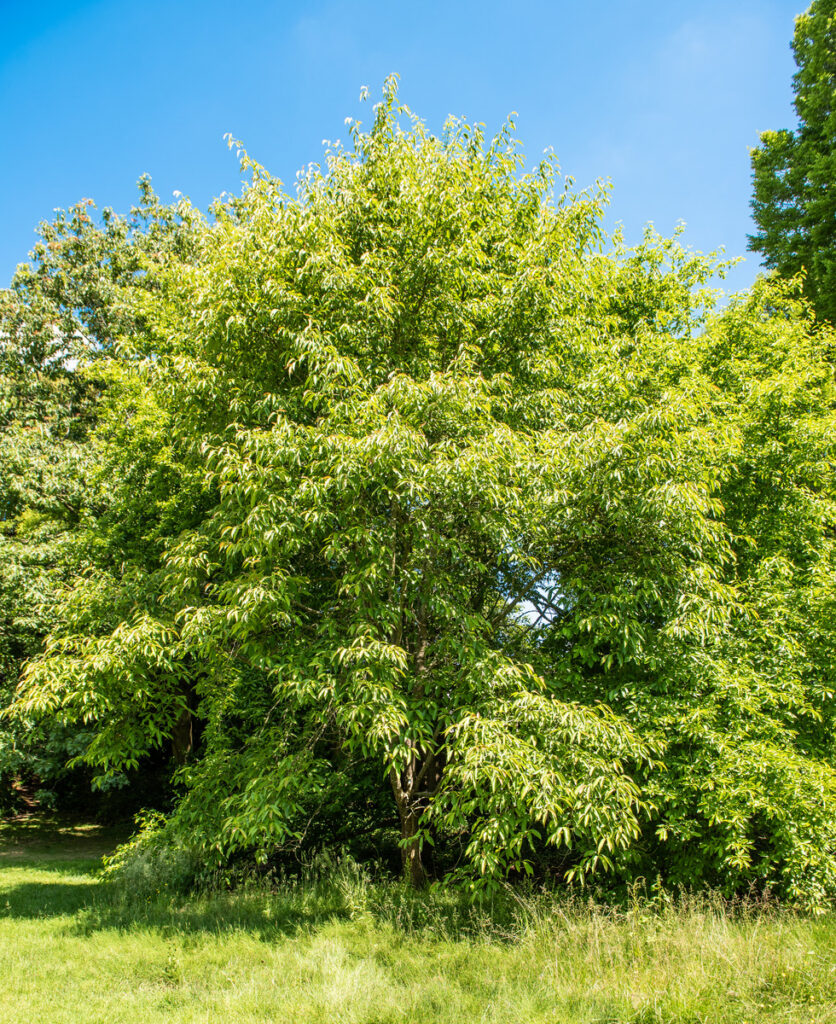
Champion Tree
Mongolian Lime
Tilia mongolica
Group: Broadleaf
Location: Keir Garden, KG24
Broadleaf tree whose leaves have fewer and more pronounced teeth than the native Small-leaved Lime. Good autumn colour. Quite erect shape making it a good alternative to the Common Lime as a street tree.
Natural range: N China & E Russia
First introduced: 1904
Park tree information & images
Label type: QR code
Height: 17.8m (Feb 2021)
Girth: 200cm at height of 1.5m (Feb 2021)
TROBI status: Girth champion of Greater London (2021)
Champion Tree
Mountain Gum (Broad-leaved Kindling Bark)
Eucalyptus dalrympleana
Group: Evergreen Broadleaf
Location: Keir Garden, KG03
Flaking, pale orange-brown bark with a distinctive scent. White flowers March-June, followed by bell-shaped fruit. Named after the forester Richard Dalrymple-Hay. Fast growing up to 40m. This tree was planted in 1990 when it was only 1m high!
Natural range: SE Australia
Park tree information & images
Label type: QR code
Height: 23.0m (Nov 2019)
Girth: 378cm at height of 0.8m (Nov 2019)
TROBI status: Height champion of Greater London (2019)
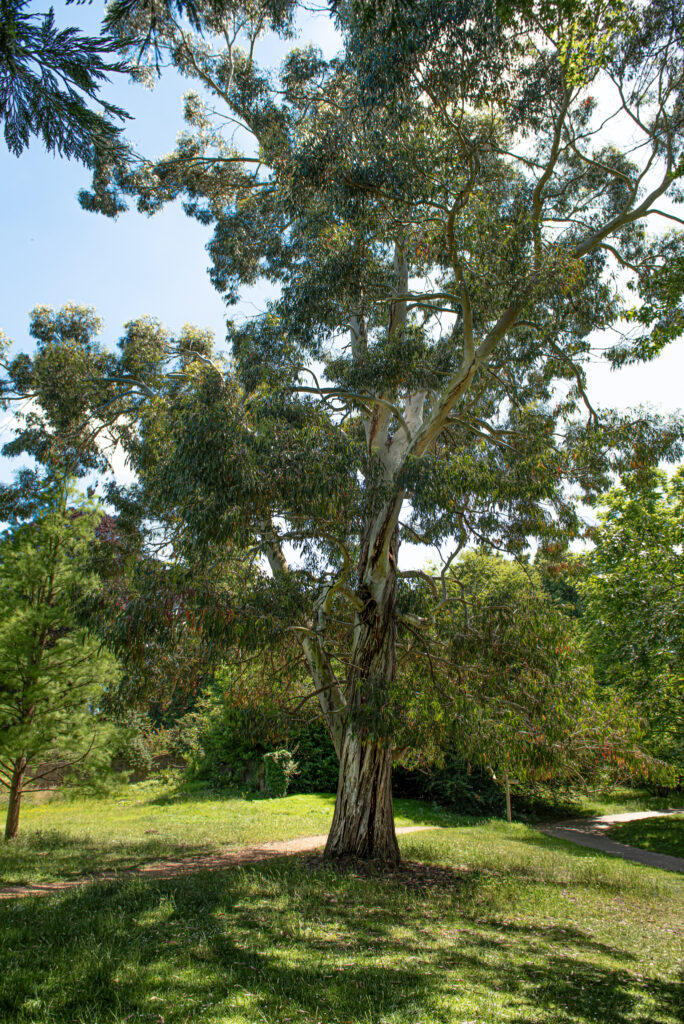
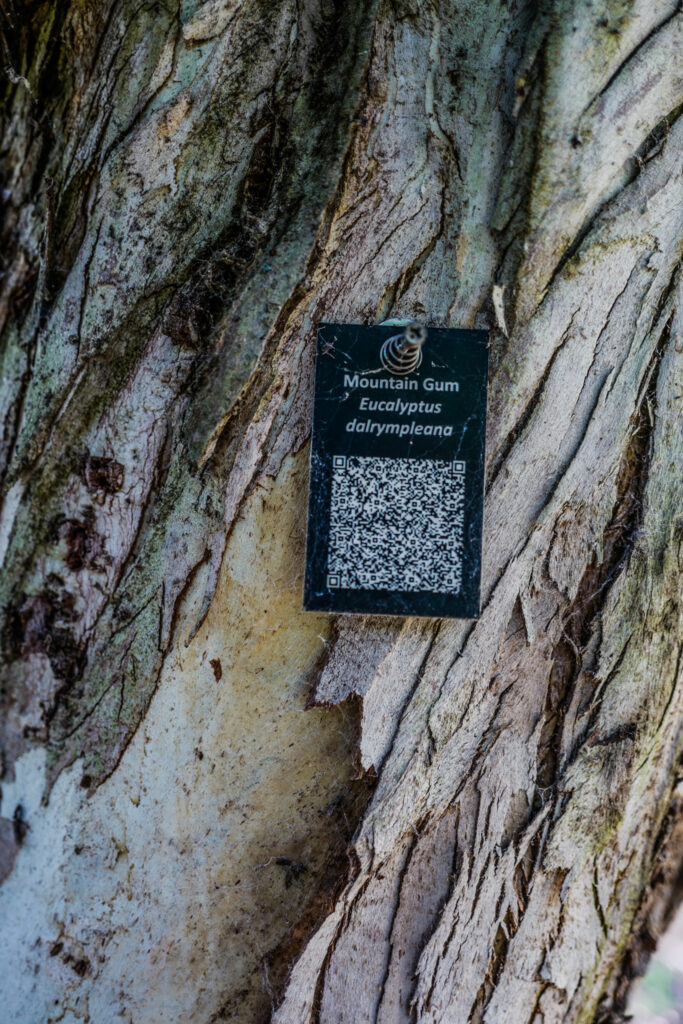
Nodding Pond Cypress
Taxodium ascendens ‘Nutans’
Group: Deciduous Conifer
Location: Keir Garden, KG05
Deciduous conifer with spreading or ascending main branches and drooping branchlets bearing soft green, linear leaves turning orange-brown in autumn. Variant of the Swamp Cypress, also found in the Park by the Pond.
Natural range: Virginia to Louisiana
Park tree information & images
Label type: QR code
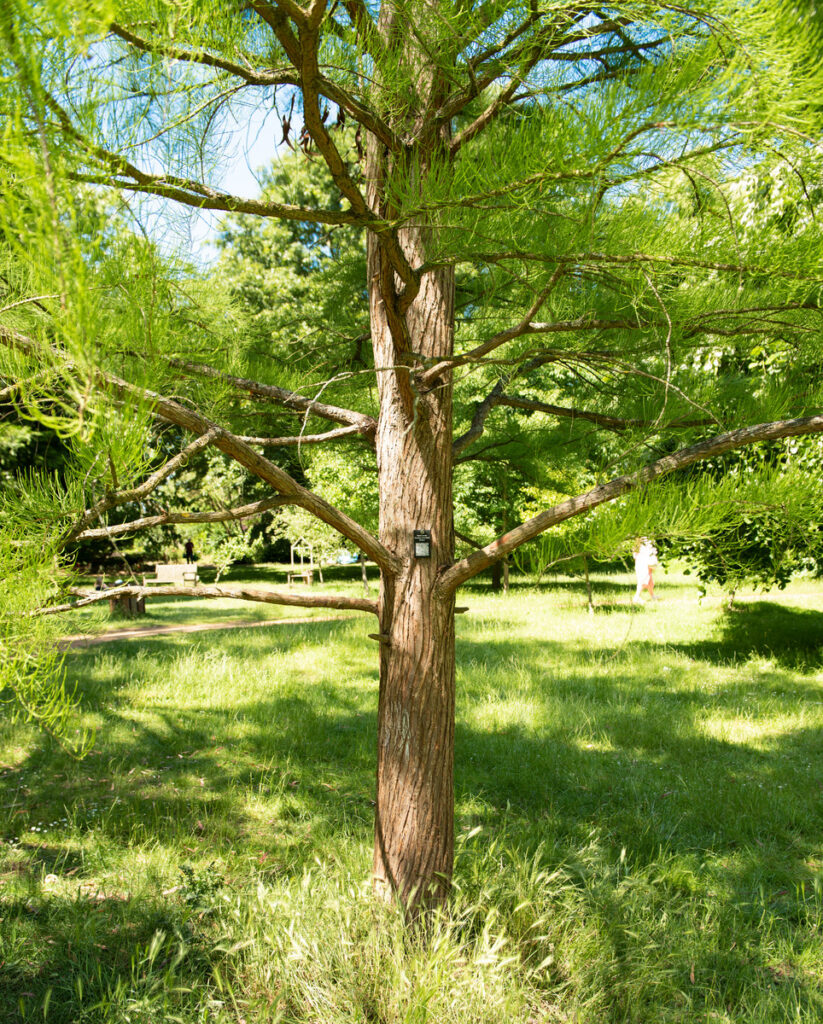
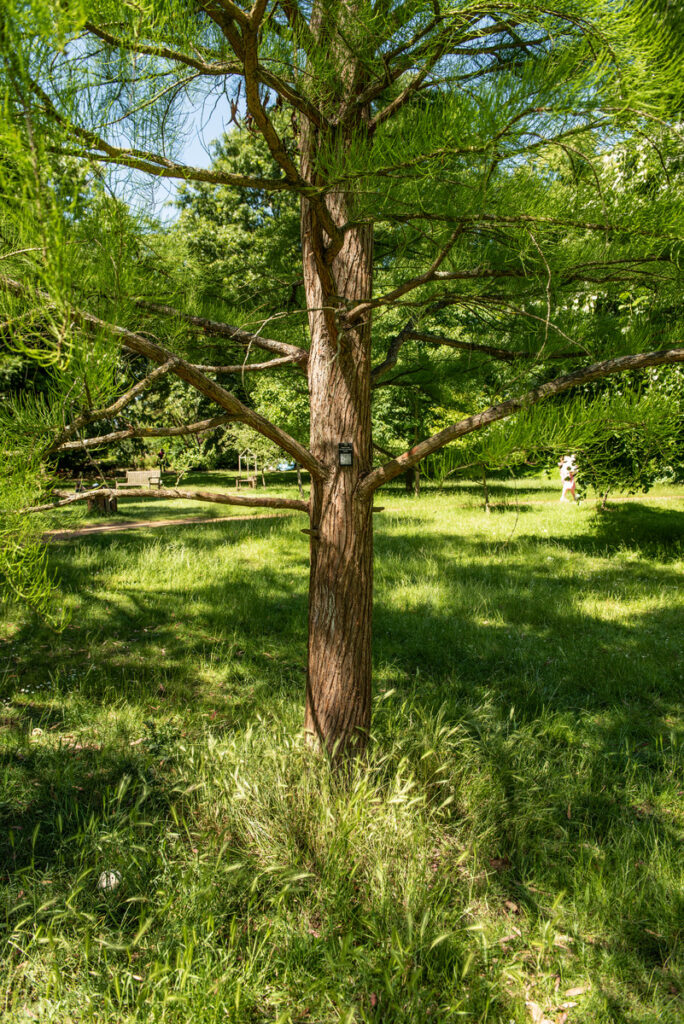
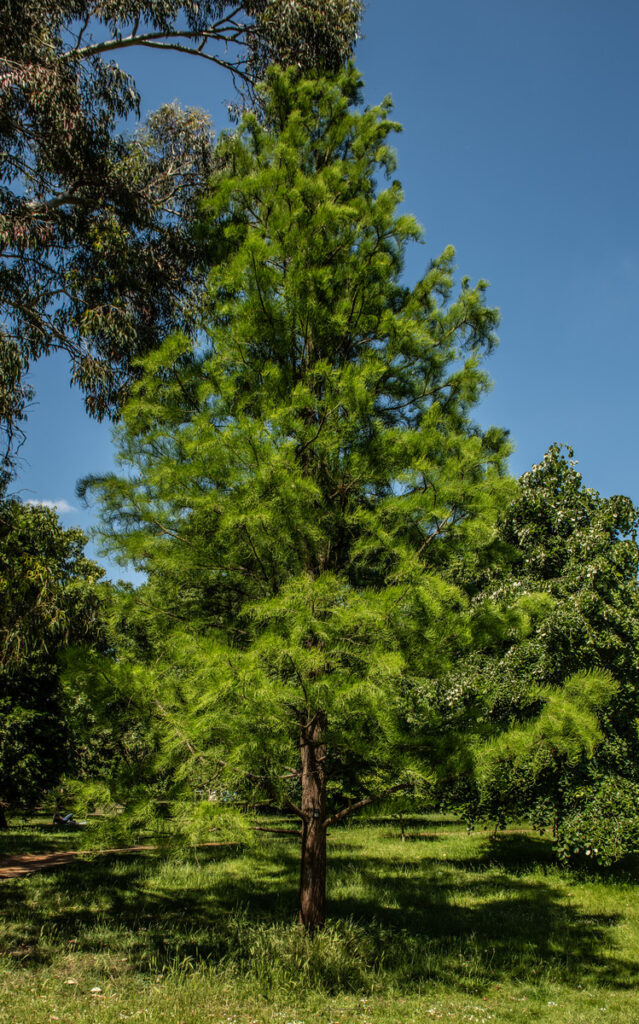
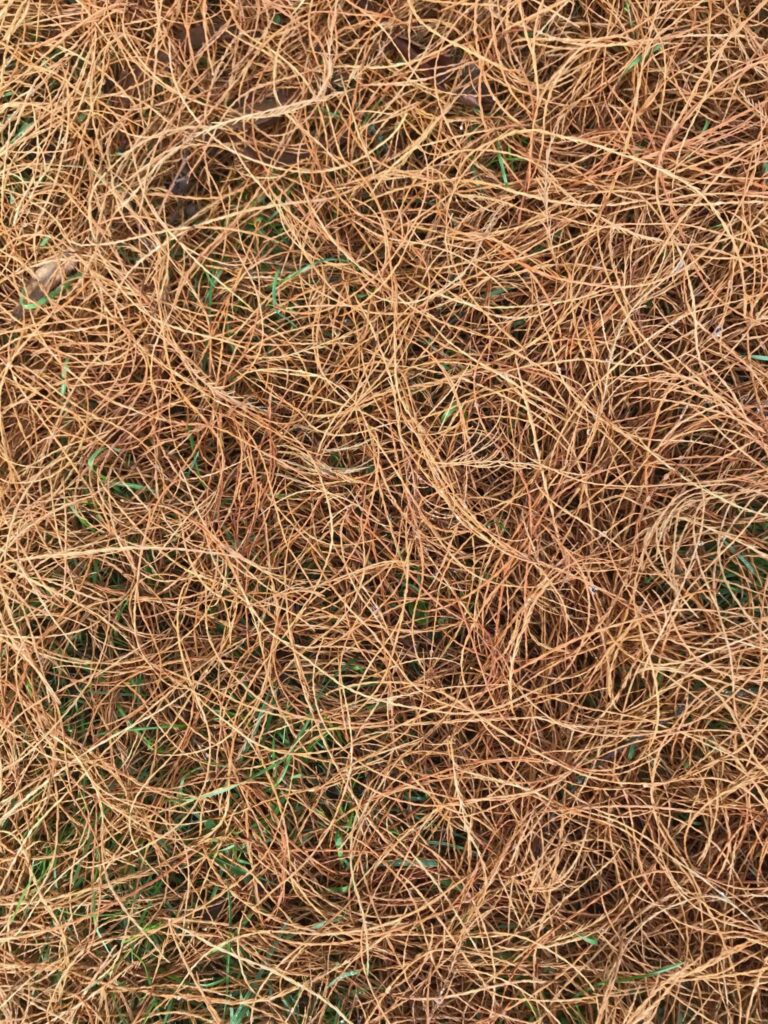
Remarkable Tree
Persian Ironwood
Parrotia persica
Group: Broadleaf
Location: Keir Garden , KG11
Wide-spreading broadleaf, often multi-stemmed, with flaking bark. Broadly oval-shaped leaves with wavy edges, which turn yellow in autumn. Small red flowers in late winter / early spring. Saplings grow from where branches reach the ground.
Natural range: Forests S of Caspian Sea
First introduced: 1841
Park tree information & images
Label type: QR code
Height: 13.4m (Apr 2021)
Girth: 204cm at height of 0.2m (Apr 2021)
TROBI status: Remarkable tree of Greater London
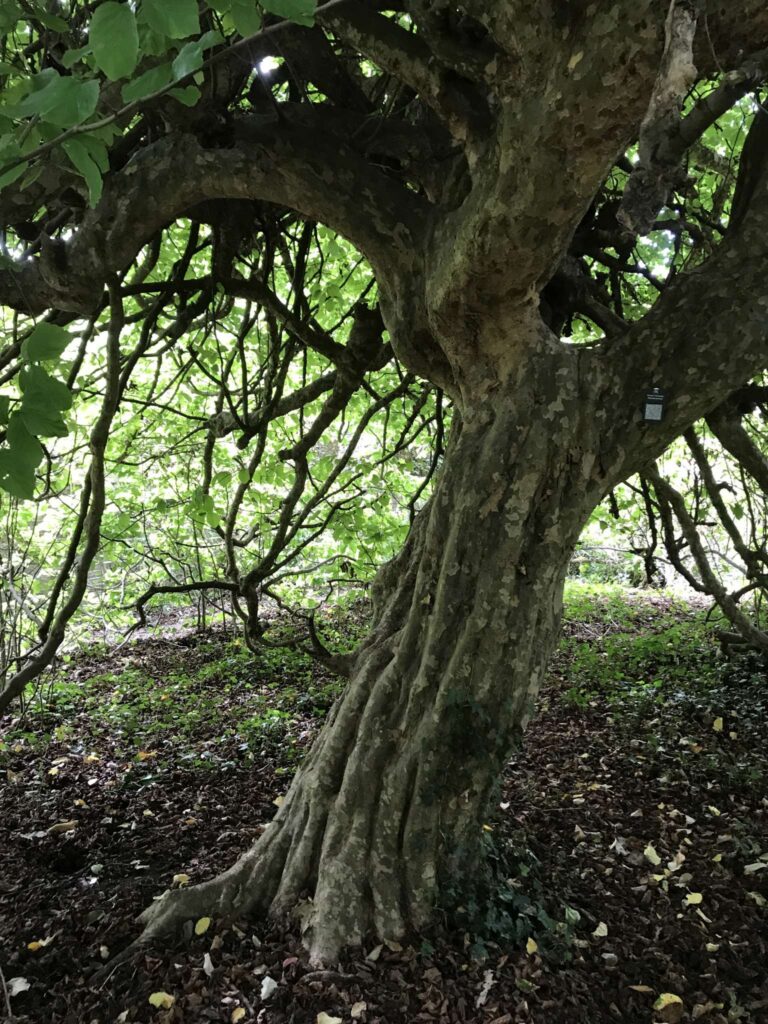
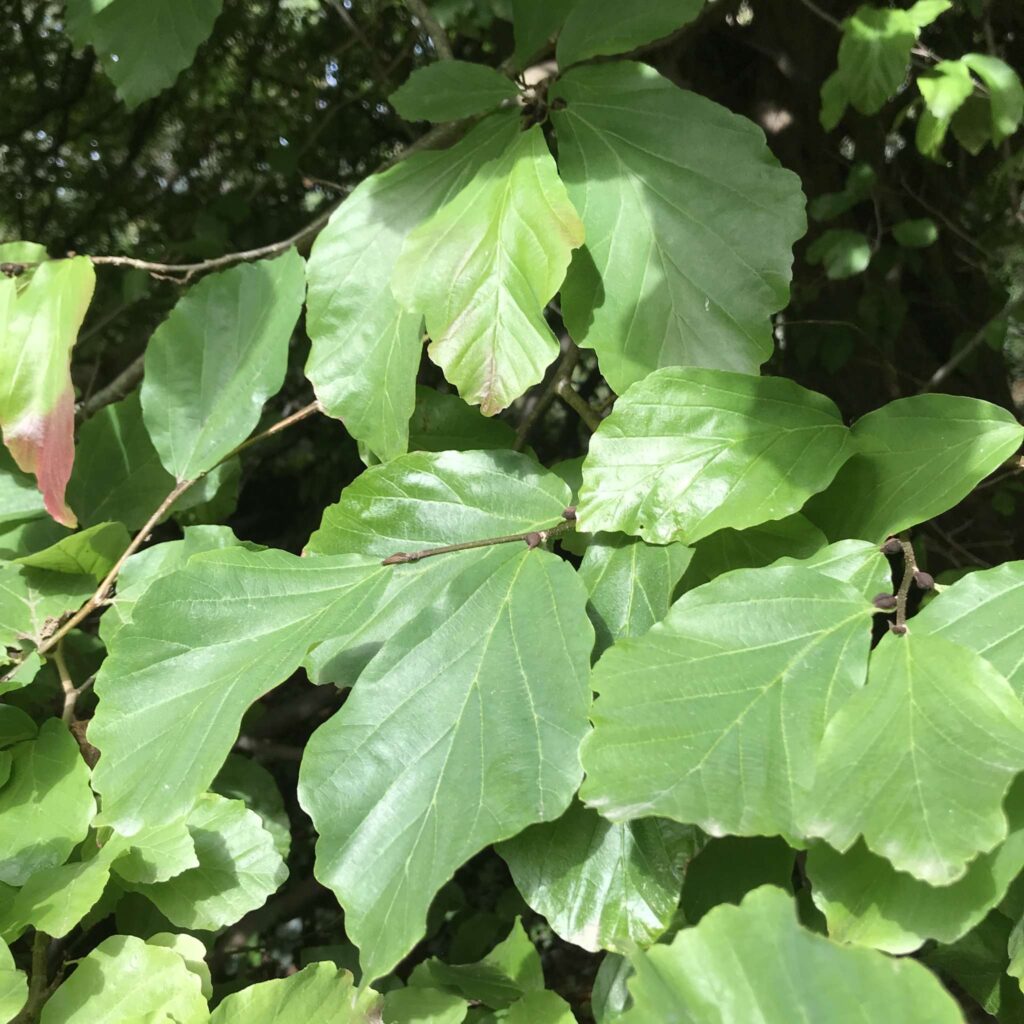
Scarlet Oak
Quercus coccinea
Group: Broadleaf
Location: Keir Garden, KG01
First American red oak to be introduced to Britain. Its leaves, which are more deeply lobed than the Red Oak (also in the Park), can turn orange-brown or deep red in autumn, but are often a disappointing warm brown. Its acorns take two years to ripen.
Natural range: SE & Central USA
First introduced: 1691
Park tree information & images
Label type: QR code
Incense Cedar
Calocedrus decurrens
Group: Conifer
Location: Keir Garden, KG21
Conifer grown in British parks and large gardens for its narrow, columnar shape. In its natural habitat it opens out with level branches. The wood is used for making pencils. Its leaves have a shoe polish aroma.
Natural range: Mid-Oregon to S California, USA
First introduced: 1853
Park tree information & images
Label type: QR code
Monterey Cypress
Cupressus macrocarpa
Group: Conifer
Location: Keir Garden, KG23
Conifer that grows into a large broad tree. Its leaves have a lemony aroma and its shiny cones, about 3cm across, have scales that are not sharply ridged. Very salt-tolerant and commonly grown in British coastal gardens to provide shelter.
Natural range: California
First introduced: 1838
Park tree information & images
Label type: QR code
Yellow Buckeye
Aesculus flava
Group: Broadleaf
Location: Keir Garden, KG14
Broadleaf tree with palm-like leaves, yellow flower candles (panicles) and spineless conker husks. Noted for its bright orange-red autumn foliage, it holds an RHS Award of Garden Merit. Its round fruit is poisonous to humans!
Natural range: E USA
First introduced: 1764
Park tree information & images
Label type: QR code
Kowhai
Sophora tetraptera
Group: Evergreen Broadleaf
Location: Keir Garden, KG22
Evergreen broadleaf with attractive ladders of foliage. Spectacular mustard-yellow flower clusters appear in late spring as the old leaves drop. Necklace-like seed pods that float, allowing dispersal by water.
Natural range: New Zealand, Chile & Tristan da Cunha
First introduced: 1772
Park tree information & images
Label type: QR code
Foxglove (Empress) Tree
Paulownia tomentosa
Group: Broadleaf
Location: Lady Jane’s Wood, LJW03
Medium-sized, extremely fast growing, broadleaf tree. Large leaves and dry fruit containing seeds. Notable for its fragrant, lilac, foxglove-like flowers, produced before leaves in spring. In China, only an empress could have one on her grave.
Natural range: W China
First introduced: 1838
Park tree information & images
Label type: QR code
Catalina Ironwood
Lyonothamnus floribundus ssp. aspleniifolius
Group: Evergreen Broadleaf
Location: Lady Jane’s Wood, LJW04
Small evergreen broadleaf tree with pretty fern-like foliage, which is glossy above and hairy below. Attractive shredding, reddish grey / brown bark. It is too tender for exposed positions in Britain.
Natural range: USA
Park tree information & images
Remarkable Tree
Coigüe (Dombey’s Beech)
Nothofagus dombeyi
Group: Evergreen Broadleaf
Location: Lady Jane’s Wood, LJW05
An evergreen Southern Beech with small, oval, dark-green leaves and horizontally wrinkled bark. It is hermaphroditic, having male and female flowers grouped on the same tree, with pollen spread by the wind.
Natural range: S Central Andes
First introduced: 1916
Park tree information & images
Label type: QR code
Height: 20.0m (Feb 2020)
Girth: 193cm at height of 1.2m (Feb 2020)
TROBI status: Remarkable tree of Greater London
Remarkable Tree
Willow Oak
Quercus phellos
Group: Broadleaf
Location: Lady Jane’s Wood, LJW06
An Oak with unusual willow-shaped, toothless and very narrow leaves, which emerge late and are initially yellow. Despite its leaf shape, it is closely related to the Red Oak. Its acorns take two years to mature.
Natural range: E USA
First introduced: 1723
Park tree information & images
Label type: QR code
Height: 19.4m (Jan 2021)
Girth: 174cm at height of 1.5m (Jan 2021)
TROBI status: Remarkable tree of Greater London
Roblé Beech
Nothofagus obliqua
Group: Broadleaf
Location: Lady Jane’s Wood, LJW07
A deciduous Southern Beech, vigorous but short-lived, with alternate, small, oval leaves in two opposite rows, which are dark green above and pale grey-green/blue below. Autumn colours are yellow and crimson. Its bark has cracked curling plates.
Natural range: S Andes
First introduced: 1902
Park tree information & images
Label type: QR code
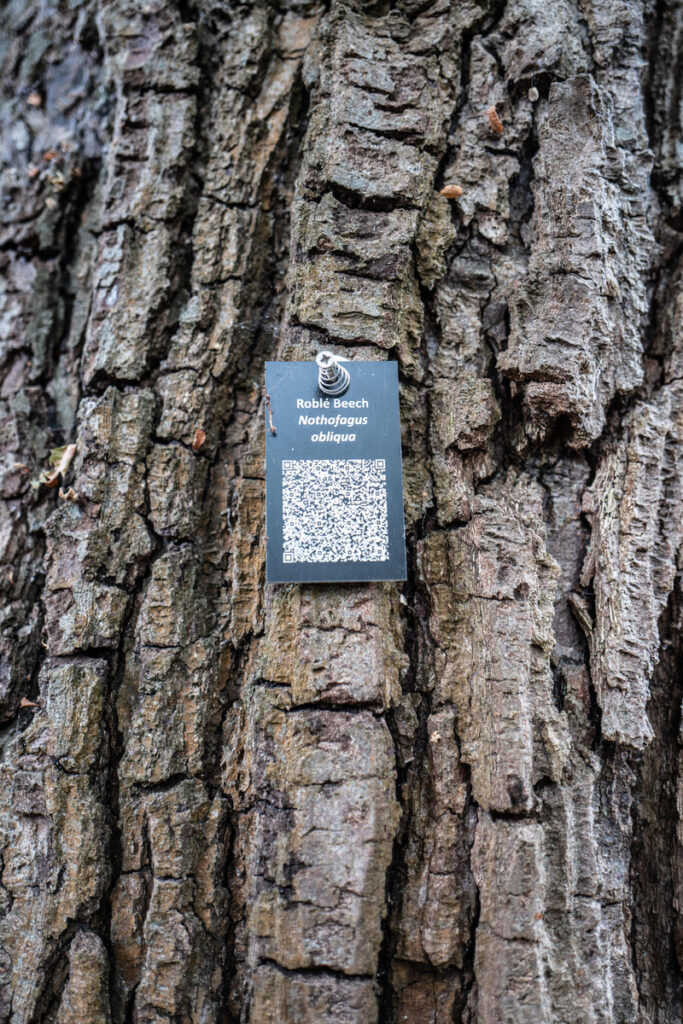
Chusan (Windmill) Palm
Trachycarpus fortunei
Group: Palm
Location: Lady Jane’s Wood, LJW10
Hardiest type of Palm with leaves in the form of a fan. This specimen was rescued from a skip at a nursery.
Natural range: China, N Vietnam & Upper Burma
First introduced: 1836
Park tree information & images
Label type: QR code
Champion Tree
Cherry Laurel
Prunus laurocerasus
Group: Evergreen Broadleaf
Location: Lady Jane's Wood, LJW11
Common evergreen hedge plant in Britain, but this one has an exceptionally large trunk, which sadly has been defaced with carvings over the years - please do not add to this. Beware, the whole plant is toxic!
Natural range: Asia Minor to Iran, Bulgaria & Serbia
First introduced: 1576
Park tree information & images
Label type: QR code
Height: 9.0m (Feb 2020)
Girth: 150cm at height of 1.2m (Feb 2020)
TROBI status: Girth champion of Greater London (2020)
Champion Tree
Campbell’s Magnolia (Sikkim)
Magnolia campbellii ssp. mollicomata
Group: Broadleaf
Location: Lady Jane's Wood, LJW02
Particularly large specimen of this broadleaf tree. Pink flowers blossom high up, usually in late March, with large deciduous leaves appearing after it has flowered.
Natural range: Himalayas to W China
First introduced: c. 1870
Park tree information & images
Label type: QR code
TROBI status: Girth & height champion of Greater London (2020)
Champion Tree
True Service
Sorbus domestica
Group: Broadleaf
Location: Lady Jane's Wood, LJW08
Broadleaf tree with serrated compound leaves in opposite pairs. Green-brown fruit up to 3cm diameter can be apple-shaped (f. pomifera) or pear-shaped (f. pyrifera). This specimen is a mature one with an impressive straight trunk.
Natural range: S Europe to Caucasus & N Africa
Park tree information & images
Label type: QR code
Height: 22.6m (Apr 2021)
Girth: 178cm at height of 1.5m (Apr 2021)
TROBI status: Height champion of Greater London (2021)
Champion Tree
Red Beech
Nothofagus fusca
Group: Evergreen Broadleaf
Location: Lady Jane's Wood, LJW13a
Southern beech that looks deciduous, but its small leaves die off, coloured yellow or red, throughout the year, so it remains in leaf all year. Its timber is durable and was often used as flooring in New Zealand. One of a nearby pair in the Park.
Natural range: New Zealand
First introduced: 1910
Park tree information & images
Label type: QR code
Height: 22.5m (Feb 2020)
Girth: 135cm at height of 1.5m (Feb 2020)
TROBI status: Girth & height champion of Greater London (2020)
Chilean Myrtle
Luma apiculata
Group: Evergreen Broadleaf
Location: Lady Jane's Wood, LJW12
Broadleaf tree with beautiful white and orange flaking bark throughout the year. Small dark evergreen leaves and white blossom in late summer. Prefers high humidity. This specimen is doing well in its location in the Park.
Natural range: S Central Andes, S America
First introduced: 1843
Park tree information & images
Label type: QR code
Yellow Birch
Betula alleghaniensis
Group: Broadleaf
Location: Lady Jane's Wood, LJW09
Broadleaf tree having leaves similar to a hornbeam and horizontally banded bark. Good autumn colour.
Natural range: Manitoba, Canada to Georgia, USA
First introduced: 1767
Park tree information & images
Label type: QR code
Height: 12.5m (Jan 2020)
Girth: 126cm at height of 1.5m (Jan 2020)
Remarkable Tree
Indian Horse Chestnut
Aesculus indica
Group: Broadleaf
Location: Main Lawn Left, MLL02
Broadleaf tree, which flowers in mid-summer, much later than the common ‘conker tree’, and has more delicately coloured flowers. Conkers are black-brown in spineless husks.
Natural range: NW Himalayas
First introduced: 1851
Park tree information & images
Label type: QR code
Height: 19.6m (Dec 2020)
Girth: 315cm at 1.5m (Dec 2020)
TROBI status: Remarkable tree of Greater London
Champion Tree
Norway Maple cultivar
Acer platanoides ‘Olmsted’
Group: Broadleaf
Location: Main Lawn Left, MLL05
Broadleaf tree with excellent yellow autumn colour. This cultivar was propagated for its fine shape and is named after Frederick Olmsted, the landscape architect who designed Central Park in New York.
First introduced: 1952 (cultivar first distributed)
Park tree information & images
Label type: QR code
TROBI status: Height champion of Greater London (2020)
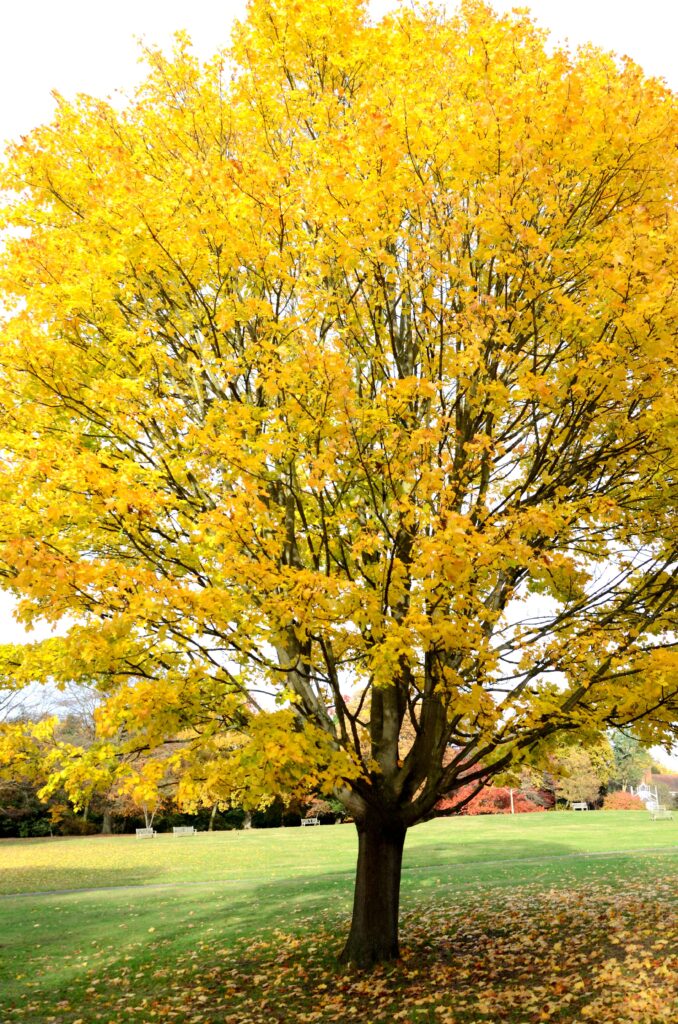
Red Oak
Quercus rubra
Group: Broadleaf
Location: Main Lawn Left, MLL14
Broadleaf tree having large leaves with shallower lobes than the Scarlet Oak. Autumn colours vary from orange-brown to deep red.
Natural range: E North America
First introduced: 1724
Park tree information & images
Label type: QR code
Height: 25.0m (Mar 2020)
Girth: 378cm at height of 1.5m (Mar 2020)
Sweet Gum (Liquidambar)
Liquidambar styraciflua
Group: Broadleaf
Location: Main Lawn Left, MLL09
Broadleaf tree with maple-like leaves. Frequent garden and park tree. Unlike some other North American trees famous for their autumn colour in their native climate, this one is reliably colourful in the English climate too.
Natural range: SE USA to Mexico
First introduced: 1681
Park tree information & images
Label type: QR code
Common Lime
Tilia x europaea
Group: Broadleaf
Location: Main Lawn Left, MLL04
Broadleaf tree, which is a hybrid of two native trees, the Broad-leaved and Small-leaved Limes. It produces a lot of sucker (epicormic) growth at the base that is often lopped when the tree is grown in streets or parks.
Natural range: Europe (including UK) although it rarely appears in the wild in the UK
Park tree information & images
Label type: QR code
Tupelo
Nyssa sylvatica
Group: Broadleaf
Location: Main Lawn Left, MLL07
Broadleaf tree quite rarely grown in this country despite its spectacular autumn colour of reds and golds. Outside of autumn difficult to spot as its form varies a lot from tree to tree.
Natural range: Ontario to NE Mexico
First introduced: Mid 18th century
Park tree information & images
Label type: QR code
Hubei (Chinese) Crab
Malus hupehensis (M. theifera)
Group: Broadleaf
Location: Main Lawn Right, MLR01
Small to medium-sized broadleaf tree with pink buds opening to prolific and fragrant white blossom in spring. Bright red, cherry-sized crab apples in autumn are a good source of food for wildlife. In China, its leaves were brewed to make tea.
Natural range: W China & Japan
Park tree information & images
Label type: QR code
Oriental Plane
Platanus orientalis
Group: Broadleaf
Location: Main Lawn Right, MLR03
Spreading broadleaf tree with deeply-lobed leaves and clusters of burr-like fruit. It is one of the parent trees of the hybrid London Plane.
Natural range: S Europe & SW Asia
Park tree information & images
Label type: QR code
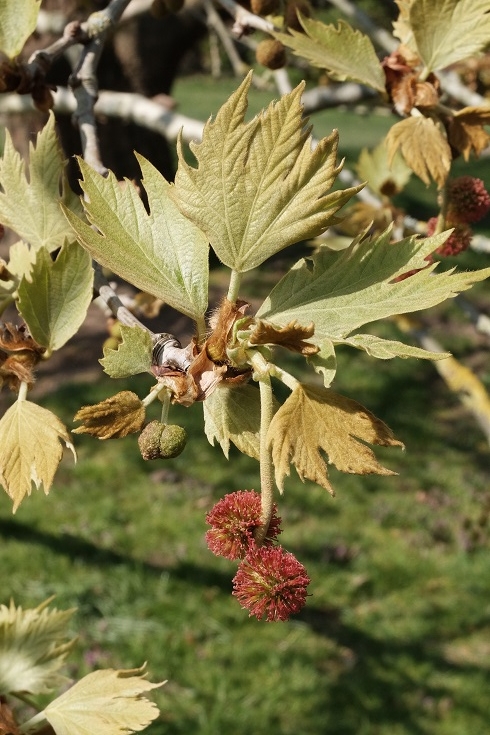
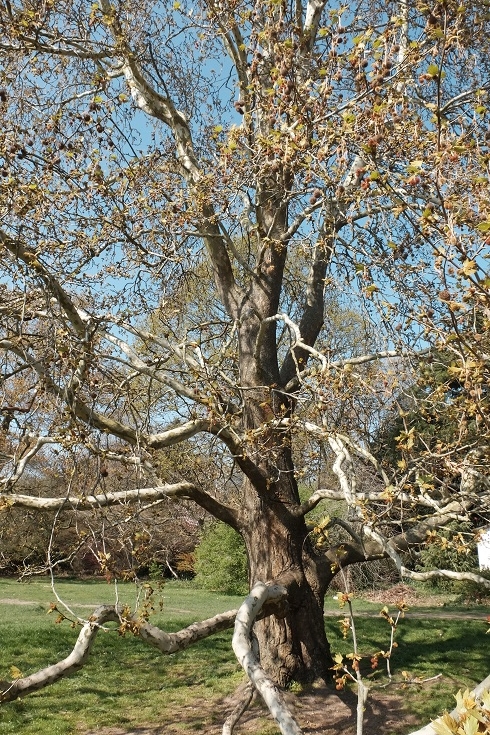
Sorrel (Sourwood)
Oxydendron arboreum
Group: Broadleaf
Location: Main Lawn Right, MLR10
Small broadleaf tree with oblong or lance-shaped leaves, which turn brilliant red in autumn. White bell-shaped flowers in long panicles appear during late summer. Juice from its flowers is used to make sourwood jelly. Renowned for its nectar, which is used to make honey.
Natural range: E North America
Park tree information & images
Cornelian Cherry
Cornus mas
Group: Broadleaf
Location: Main Lawn Right, MLR11
Broadleaf tree, which has yellow flowers in late winter. Its common name is a reference to the cherry-like red fruits, but it is a Dogwood, not a Cherry. The specimen in the Park is a particularly large one.
Natural range: S Europe and W Asia, but long grown in Britain
Park tree information & images
Label type: QR code
Champion Tree
Bitternut
Carya cordiformis
Group: Broadleaf
Location: Main Lawn Right, MLR05
A broadleaf tree, one of the hickories. Closely related to the Pecan, but has bitter, inedible nuts, hence its common name. Leaves turn bright yellow in autumn. The Pignut is another hickory growing in the Park in Birch Grove.
Natural range: North America, Quebec to East Texas
First introduced: 1689
Park tree information & images
Height: 27.0m (Nov 2019)
Girth: 235cm at height of 1.5m (Nov 2019)
TROBI status: Girth & height champion of Greater London (2019)
Remarkable Tree
Montpelier Maple
Acer monspessulanum
Group: Broadleaf
Location: Main Lawn Right, MLR07
Broadleaf tree with leathery, glossy, dark-green, 3-lobed leaves. Pendants of yellow-green flowers in spring, followed by red-winged fruit in summer. Can be mistaken for Field Maple, but has a simpler leaf shape.
Natural range: S & Central Europe, SW Asia & North Africa
First introduced: 1739
Park tree information & images
Label type: QR code
Height: 9.5m (Jan 2020)
Girth: 163cm at height of 0.8m (Jan 2020)
TROBI status: Remarkable tree of Greater London (2020)
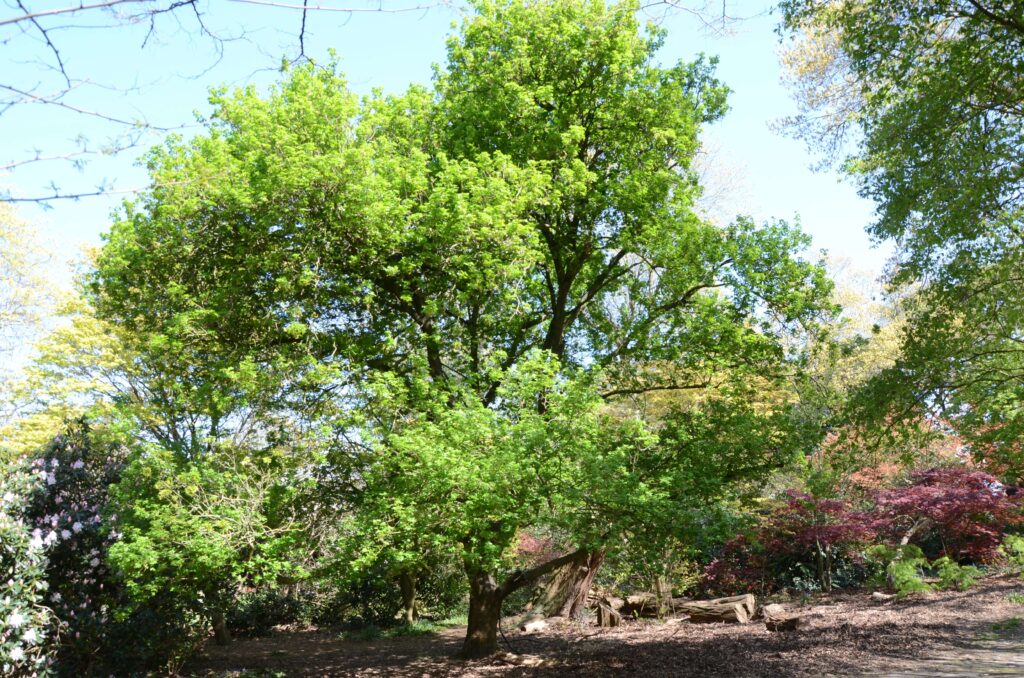
Turner's Oak
Quercus x turneri ‘Pseudoturneri’
Group: Broadleaf
Location: Main Lawn Right, MLR09
Broadleaf tree produced by crossing English Oak with Holm Oak resulting in an evergreen oak hybrid. Square-cracked bark is similar to Holm Oak’s bark. Named after the 18 h century nurseryman Spencer Turner who first grew the hybrid in Leyton, London.
First introduced: Before 1776 (first hybridised)
Park tree information & images
Label type: QR code
Beech cultivar
Fagus sylvatica ‘Dawyck Gold’
Group: Broadleaf
Location: Main Lawn Right, MLR16
Broadleaf tree propagated in Scotland’s Dawyck Botanic Garden from a seedling (Dawyck Beech) discovered in 1860 in a nearby wood. Notable for its golden-yellow foliage in spring and autumn, and its column-like shape.
Park tree information & images
Label type: QR code
Cypress Oak
Quercus robur f. fastigiata
Group: Broadleaf
Location: Maple Avenue, MA01
Tall, columnar cultivar of the English Oak with a similar shape to a Cypress or Lombardy Poplar, but with twisted branches. Leaves and acorns are the same as an English Oak. It was originally propagated from an upright tree that was found in central Europe.
Park tree information & images
Label type: QR code
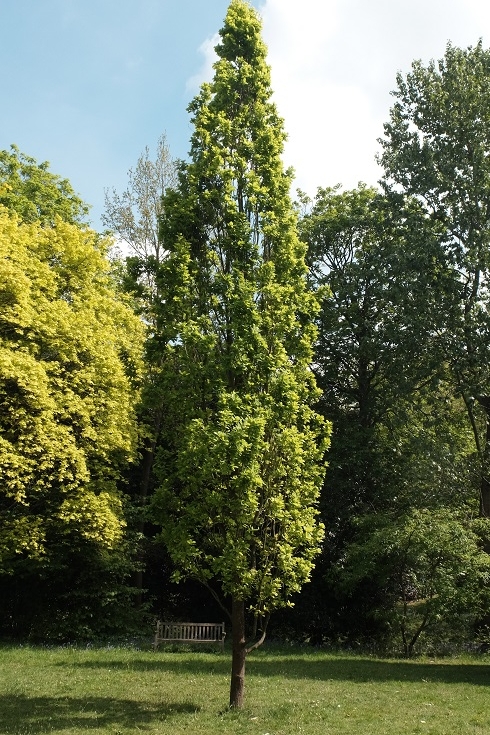

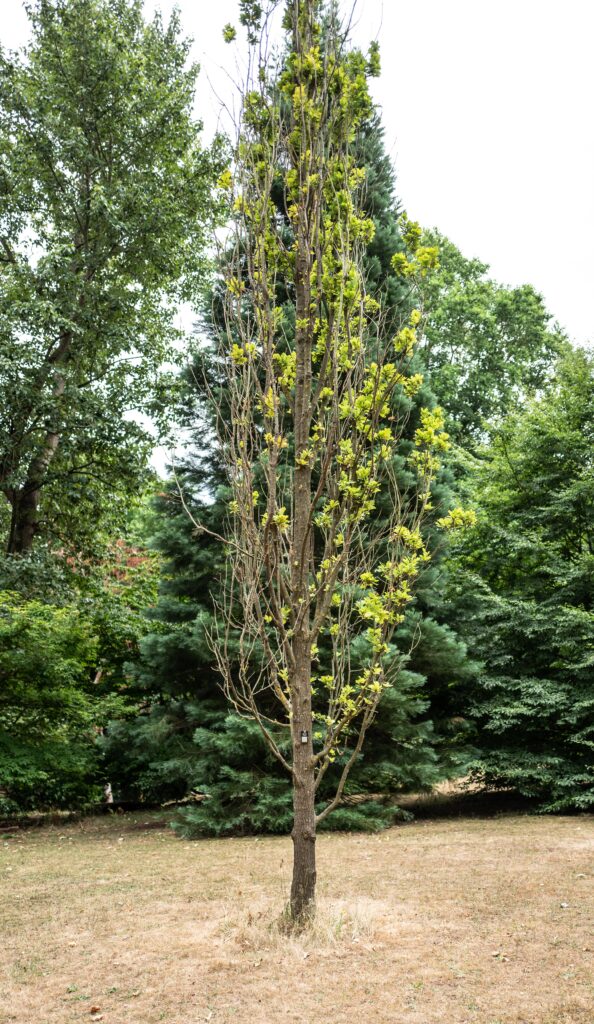
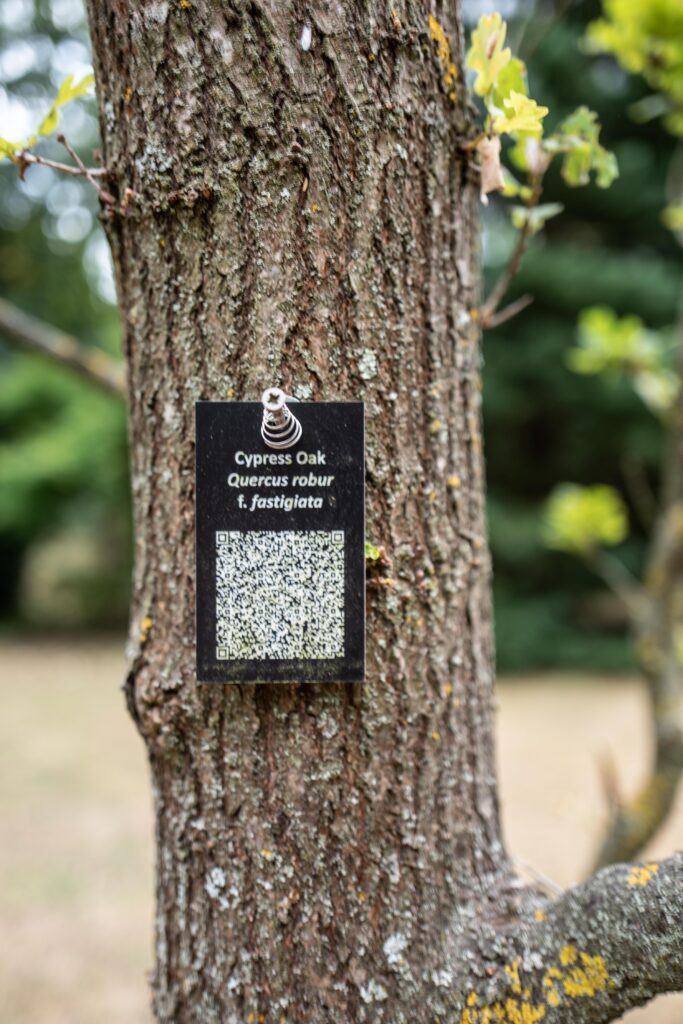
Remarkable Tree
Tulip Tree variant
Liriodendron tulipifera ‘Aureomarginatum’
Group: Broadleaf
Location: Maple Avenue, MA05
The Park has several mature broadleaf tulip trees, but this one is a quite rare variant with lighter colour at the margin of the leaves, which is more obvious in spring and early summer. Good autumn colour.
Natural range: E North America
First introduced: 17th century
Park tree information & images
Label type: QR code
Height: 22.0m (Feb 2020)
Girth: Twin trunk - 172, 158cm at height of 1.5m (Feb 2020)
TROBI status: Remarkable tree of Greater London (2020)
Field Maple
Acer campestre
Group: Broadleaf
Location: Maple Avenue, MA02
Broadleaf tree up to 25m tall, with finely fissured and somewhat corky bark. Leaves are in opposite pairs, each with five rounded lobes. Flowers produced in spring at same time as leaves open. Yellow leaves and winged fruit in autumn. Strong, hard wood used to make musical instruments.
Natural range: Europe
Park tree information & images
Label type: QR code
Cappadocian Maple
Acer cappadocicum
Group: Broadleaf
Location: Maple Avenue, MA03
Broadleaf tree often grown as a street tree. Leaves have the familiar maple look usually with 5 lobes, but they are untoothed, unlike those of the Sycamore and Norway Maple. Excellent autumn colour.
Natural range: Caucasus to China
First introduced: 1838
Park tree information & images
Label type: QR code
Purple Sycamore
Acer pseudoplatanus f. purpureum
Group: Broadleaf
Location: Maple Avenue, MA09
Broadleaf tree, a variant of the sycamore, which can appear naturally in the wild. Leaves are purple on the underside and like all Acers it has winged seeds, known as keys.
Natural range: Europe N to Paris, but long naturalised in Britain (species range)
Park tree information & images
Label type: QR code
Horse Chestnut
Aesculus hippocastanum
Group: Broadleaf
Location: Maple Avenue, MA11
Broadleaf tree with candle-shaped flowers (panicles) in May and conkers in autumn. The leaf stalks leave a horseshoe-shaped scar on the twig when they fall and the conkers were used for horse medicine.
Natural range: N Greece & Albania
First introduced: 1616
Park tree information & images
Label type: QR code
Blue Atlas Cedar
Cedrus atlantica ‘Glauca’
Group: Conifer
Location: Maple Avenue, MA12
Large conifer with silvery-blue, needle-like leaves arranged spirally on young shoots and barrel-shaped cones. Conical shape when young, but broadens with age into spreading, flat-topped tree up to 35m tall.
Natural range: Atlas Mountains Morocco & Algeria
Park tree information & images
Label type: QR code
Giant Redwood
Sequoiadendron giganteum
Group: Conifer
Location: Maple Avenue, MA06
Conifer that grows into the world’s largest trees and often confused with the Coast Redwoods (also in the Park), the world’s tallest trees. Its leaves are on cord-like shoots and spongy bark protects the tree from forest fires.
Natural range: Sierra Nevada, California
First introduced: 1853
Park tree information & images
Label type: QR code
Corstorphine Plane
Acer pseudoplatanus ‘Corstorphinense’
Group: Broadleaf
Location: Maple Avenue, MA08
Rare sycamore variant, whose golden-yellow leaves fade to green after six weeks. The name comes from an ancient sycamore with this distinctive foliage, which formerly stood in the village of Corstorphine, now a suburb of Edinburgh.
First introduced: 15th century
Park tree information & images
Label type: QR code
Cappadocian Maple variant
Acer cappadocicum ‘Aureum’
Group: Broadleaf
Location: Maple Avenue, MA10
Broadleaf tree with leaves having whisker-tipped lobes, yellow in spring, but gradually fading to green through the summer. There are several specimens nearby in the Park. A non-variant tree stands next to this one.
Natural range: Caucasus to China (species range)
First introduced: 1838 (species)
Park tree information & images
Label type: QR code
Maritime (Cluster) Pine
Pinus maritima (pinaster)
Group: Conifer
Location: Mediterranean Garden, MG03
Conifer from the Mediterranean coastal area, but grown in Britain for many years. Long stout pine needles in pairs. 10cm long, shiny, brown cones.
Natural range: Med coasts from Portugal to Greece & Morocco.
Park tree information & images
Label type: QR code
Variegated Chestnut
Castanea sativa ‘Albomarginata’
Group: Broadleaf
Location: Mediterranean Garden, MG05
Variant of the Sweet Chestnut with a distinctive creamy-white margin to its toothed, spear-shaped leaves. Pale yellow catkins appear in early summer. The Sweet Chestnut was brought to Britain by the Romans.
Park tree information & images
False Acacia variant (Black Locust)
Robinia pseudoacacia ‘Pyramidalis’
Group: Broadleaf
Location: Mediterranean Garden, MG08
Variant of the False Acacia but having a much thinner shape, similar to a Lombardy Poplar. There is a mature specimen of the ordinary False Acacia nearby just off the same path.
First introduced: 1839
Park tree information & images
Label type: QR code
Height: 18.4m (Feb 2021)
Girth: 72cm at height of 1.5m (Feb 2021)
English Oak (Pedunculate Oak)
Quercus robur
Group: Broadleaf
Location: Mediterranean Garden, MG01
Native broadleaf tree, which has acorns on the end of a stalk (peduncle), giving it one of its common names. The other native oak, the Sessile Oak, has acorns sitting on its twig, hence its name.
Natural range: Europe, including Britain, to the Caucasus
Park tree information & images
Label type: QR code
Black Pine
Pinus nigra
Group: Conifer
Location: Mediterranean Garden, MG02
Large conifer with needles in pairs and attractive bark. Often with single, unforked stem, but this specimen has an impressive forked one, hence its local nickname of ‘Catapult Tree’.
Natural range: Central & S Europe
First introduced: 1759
Park tree information & images
Label type: QR code
Pagoda Tree
Stryphnolobium japonicum (Sophora japonica)
Group: Broadleaf
Location: Mediterranean Garden, MG06
Broadleaf tree with smooth compound leaves. Hanging creamy-white flowers appear on older trees after hot summers. Seed pods up to 8cm long, but rare in the UK. Flowers and fruits are much used in Chinese herbal medicine.
Natural range: China & Korea
First introduced: 1753 (Kew)
Park tree information & images
Label type: QR code
Sweet Chestnut
Castanea sativa
Group: Broadleaf
Location: Mediterranean Garden, MG09
Broadleaf tree probably brought to Britain by the Romans. Its nuts grow smaller than in Southern Europe and were consequently less useful as a source of food in this country. In very old trees the vertical ridges in the bark spiral, usually clockwise.
Natural range: S Europe, North Africa & Asia Minor
Park tree information & images
Label type: QR code
Bhutan Pine
Pinus wallichiana
Group: Conifer
Location: Mediterranean Garden, MG15
Conifer having long silky grey-green needles that droop attractively, together with long cones. Can grow to more than 30m. Often grown in urban parks, it has good resistance to air pollution.
Natural range: Himalayas
First introduced: 1823
Park tree information & images
Label type: QR code
Weymouth Pine
Pinus strobus
Group: Conifer
Location: Mediterranean Garden, MG19
Conifer growing to over 40m with slender cones. Named after Captain George Weymouth, who returned to England from New England with seeds or seedlings. Produces good timber, but hard to grow commercially here because of white pine blister rust disease.
Natural range: E North America
First introduced: 1605
Park tree information & images
Label type: QR code
Tulip Tree (Yellow Poplar)
Liriodendron tulipifera
Group: Broadleaf
Location: Old Herbaceous Border, OHB02
Large and vigorous broadleaf tree with distinctive deeply-waisted leaves having a V-shaped apex. Leaves turn butter-yellow in autumn. Erect-sitting, yellow-green, tulip-shaped flowers with an orange band. State tree of Indiana, Kentucky and Tennessee.
Natural range: E North America
Park tree information & images
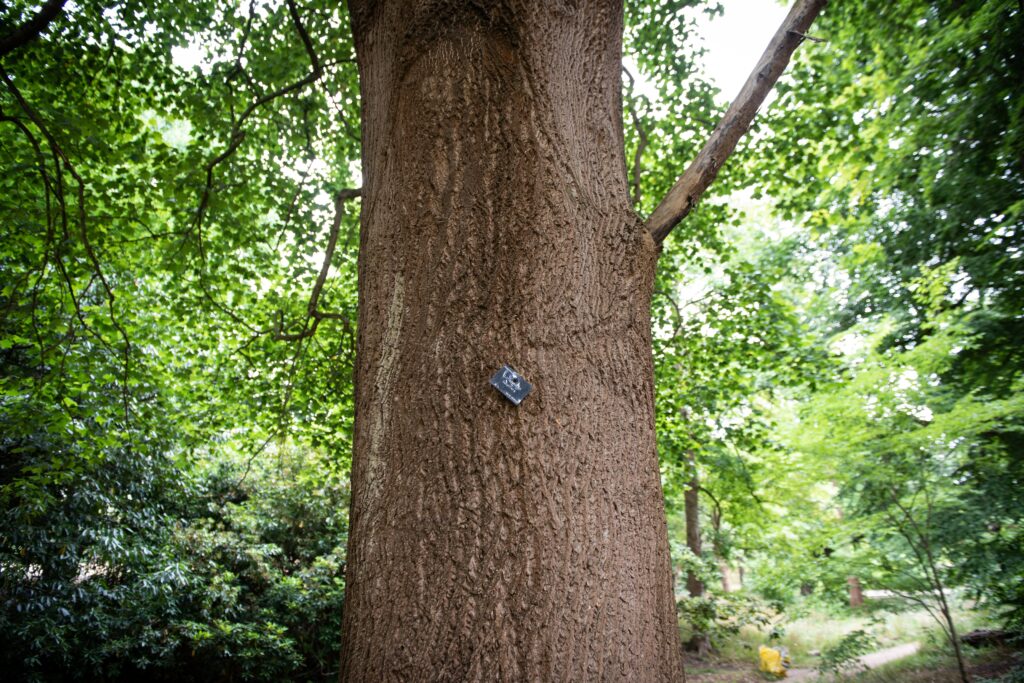
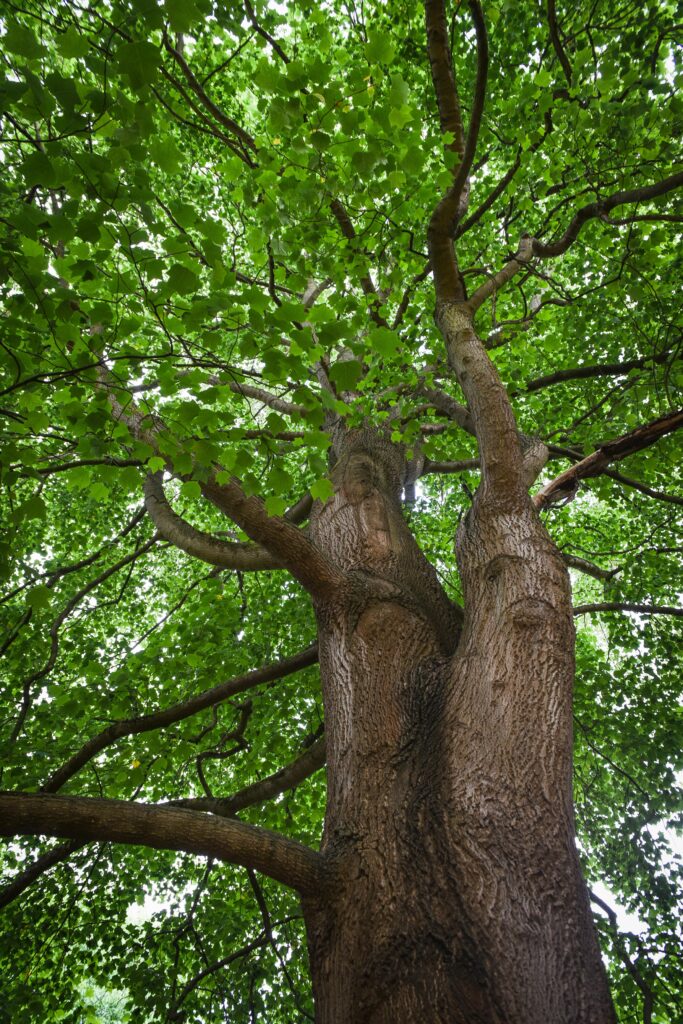
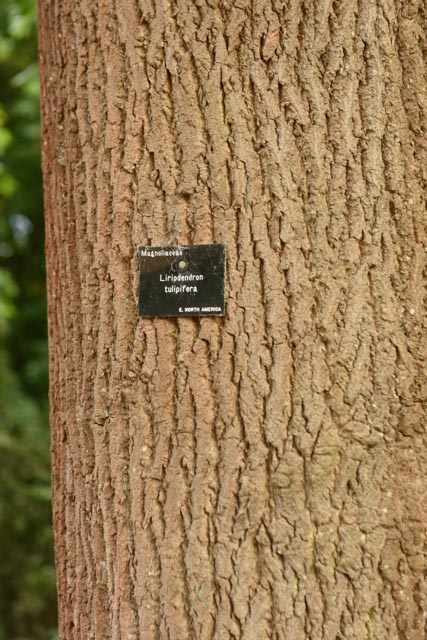
Black Walnut
Juglans nigra
Group: Broadleaf
Location: Old Herbaceous Border, OHB03
Large broadleaf tree named for its bark colour. Male catkins and female flower-clusters appear in late spring. In autumn, flowers turn to brownish-green fruit. Its roots contain a chemical which prevents many plants growing nearby. It is frequently used in herbal medicine.
Natural range: E North America
Park tree information & images
Japanese Thuja
Thuja standishii
Group: Conifer
Location: Old Herbaceous Border, OHB01
Conifer with leaves on nodding sprays. One of a pair in the Park, both having an attractive shape.
Natural range: Japan
First introduced: 1860
Park tree information & images
Label type: QR code
Handkerchief (Dove) Tree
Davidia involucrata
Group: Broadleaf
Location: Pond, P04
Medium-sized, broadleaf tree with bright green, broadly oval-shaped leaves up to 15 cm in length. In late spring it produces spectacular handkerchief-like pairs of white flower-bracts up to 20 cm in length, surrounding very small flowers.
Natural range: Western China
First introduced: 1901
Park tree information & images
Label type: QR code
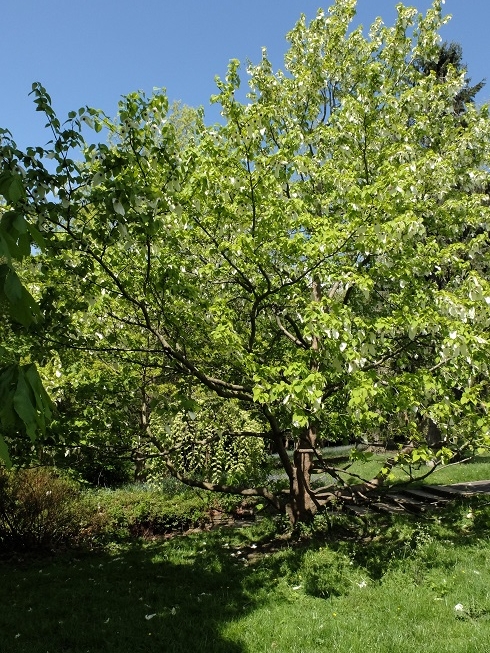
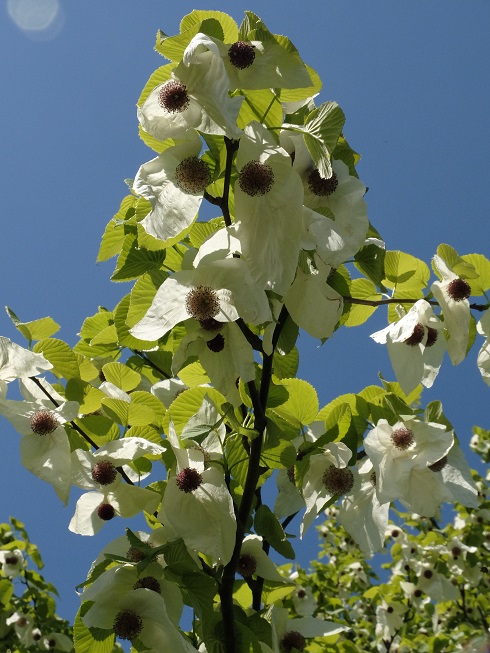
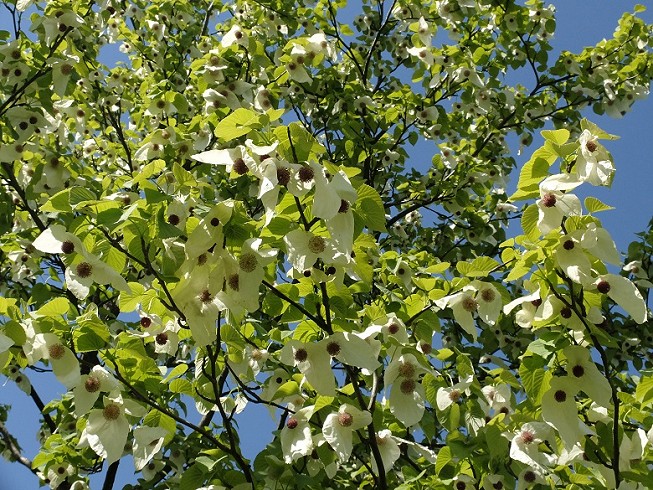
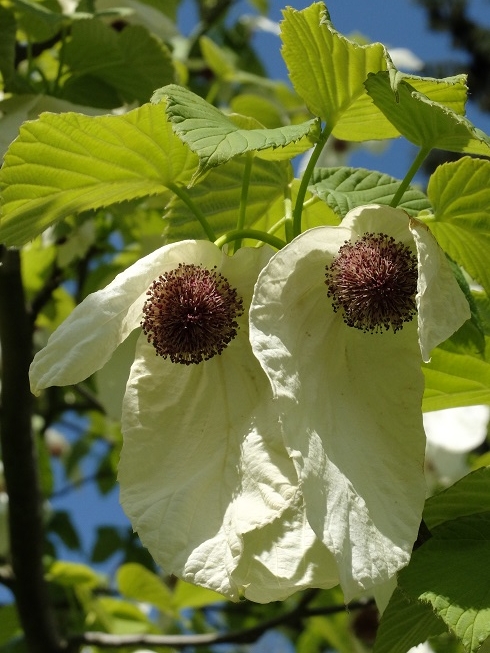
Young’s Weeping Birch
Betula pendula ‘Youngii’
Group: Broadleaf
Location: Pond, P06
Variant of the Silver Birch, forming a dome-shaped crown of arching branches weeping to the ground. Yellow-brown catkins appear in spring, falling before the arrival of serrated, oval-shaped leaves, which turn yellow in autumn. Beautiful skeletal form in winter.
Natural range: N Europe & Asia
Park tree information & images
Label type: QR code
Champion Tree
Brewer Spruce
Picea breweriana
Group: Conifer
Location: Pond, P05
Rare conifer with distinctive crown, featuring level branches with branchlets, forming a curtain of foliage. Slow-growing, with single needle-like leaves and long cones (8-15cm). Named after American botanist William Brewer.
Natural range: W North America
Park tree information & images
Label type: QR code
Height: 17.0m (Nov 2019)
Girth: 137cm at height of 1.5m (Nov 2019)
TROBI status: Girth & height champion of Greater London (2019)
Swamp Cypress
Taxodium distichum
Group: Deciduous Conifer
Location: Pond, P03
Deciduous conifer with strong grey-red bark and russet-red needles in autumn. Slow-growing to 20m and long-lived. Tolerates water-logged conditions and has woody, knee-like projections (pneumatophores) to trap silt and probably help its roots breathe.
Natural range: SE North America
First introduced: 1640
Park tree information & images
Label type: QR code
Veteran Tree
English Oak (Pedunculate Oak) - P13
Quercus robur
Group: Broadleaf
Location: Pond, P13
Veteran pollard.
Park tree information & images
Label type: None
Girth: 549cm at height of 1.5m (2011)


Veteran Tree
English Oak (Pedunculate Oak) - P15
Quercus robur
Group: Broadleaf
Location: Pond, P15
Veteran maiden.
Park tree information & images
Label type: None
Girth: 476cm at height of 1.0m (2011)
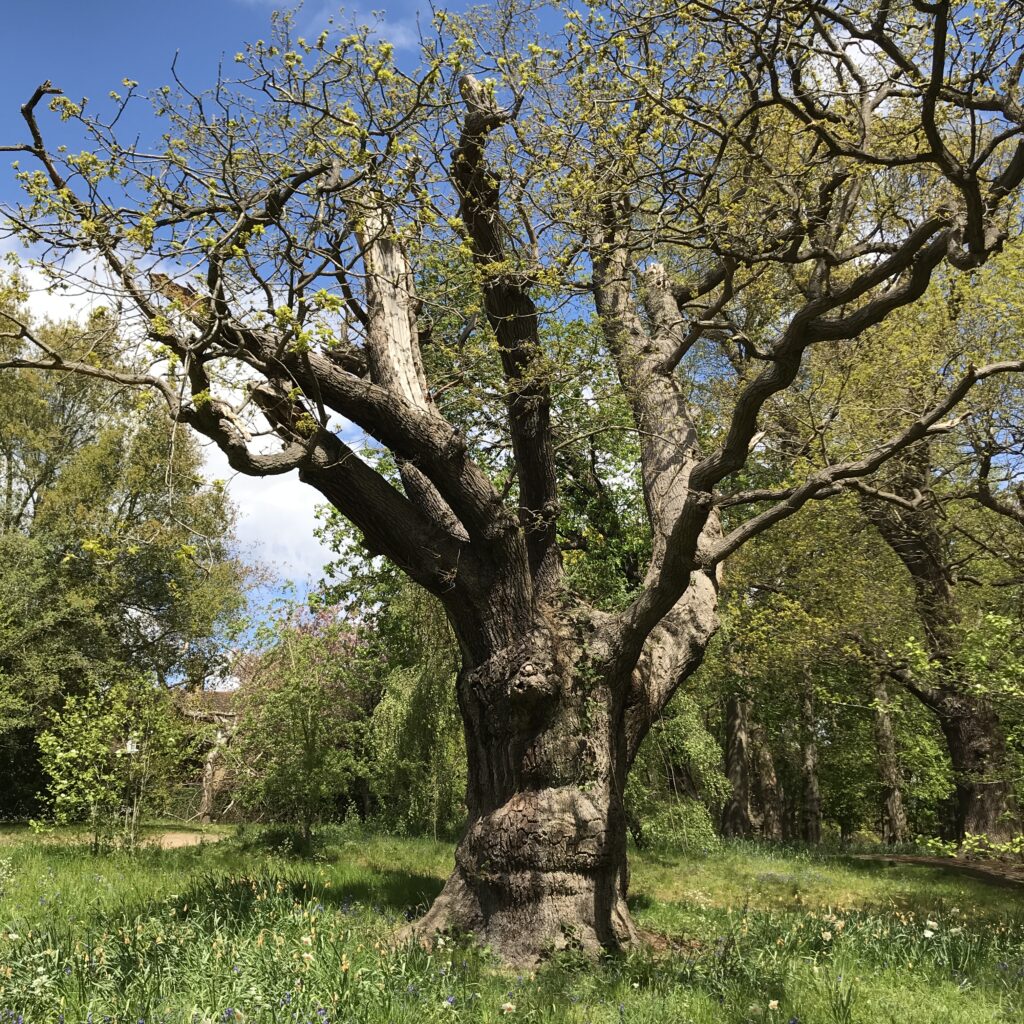
Veteran Tree
English Oak (Pedunculate Oak) - P16
Quercus robur
Group: Broadleaf
Location: Pond, P16
Veteran maiden.
Park tree information & images
Label type: None
Girth: 394cm at height of 1.5m (2011)
Daimyo Oak
Quercus dentata
Group: Broadleaf
Location: Pond, P09
Broadleaf tree with giant leaves (unusual for an oak) that have the texture of parchment in autumn and winter, when they are often late to fall. In Korea the starch from the acorns is traditionally used to make acorn jelly (dotori-muk).
Natural range: Japan, Korea & NE China
First introduced: 1830
Park tree information & images
Label type: QR code
Japanese Horse Chestnut
Aesculus turbinata
Group: Broadleaf
Location: Pond, P01
Rare broadleaf tree, which grows up to 20m. Large, candle-shaped flowers (panicles) up to 30cm long, which are yellowish-white with red spots. Very large leaves, up to 40x15cm. Smooth, pear-shaped fruits in autumn and sticky buds in winter/spring.
Natural range: Japan
First introduced: c.1880
Park tree information & images
Label type: QR code
Castor Aralia (Prickly Castor Oil Tree)
Kalopanax septemlobus (K. pictus)
Group: Broadleaf
Location: Retreat Path, RP01
Broadleaf tree whose alternative common name is misleading as the plant is not related to the castor oil plant, but is a good descriptive name since it has similar large leaves and its branches are very spiky.
Natural range: E Asia
First introduced: 1864
Park tree information & images
Label type: QR code
Date-Plum
Diospyros lotus
Group: Broadleaf
Location: Retreat Path, RP03
One of the oldest cultivated fruit trees in the world. In the UK the fruit does not ripen enough to be edible. The small fruit is said to have a taste similar to dates and plums, hence its common name. Small urn-shaped flowers in mid-summer.
Natural range: SW Asia & SE Europe
Park tree information & images
Label type: QR code
Grand Fir
Abies grandis
Group: Conifer
Location: Retreat Path, RP04
Conifer that is the tallest fir grown in Britain, potentially reaching over 50m, with slender cones high up. Introduced to Britain by the adventurer David Douglas who trekked across Western North America collecting seeds.
Natural range: Vancouver to California
First introduced: 1832
Park tree information & images
Label type: QR code
Remarkable Tree
Hackberry (Nettle-tree)
Celtis occidentalis
Group: Broadleaf
Location: Rose Garden, RG02
Broadleaf tree with Interesting bark on mature specimens, such as this Hackberry in the Park. Small green flowers are followed by red/purple berries. Rare in the UK, but a popular street tree in Serbia and Slovakia.
Natural range: E North America
First introduced: 1656
Park tree information & images
Label type: QR code
Height: 13.5m (Nov 2020)
Girth: Twin trunk - 178, 175cm at height of 1.5m (Nov 2020)
TROBI status: Remarkable tree of Greater London
Remarkable Tree
Golden Rain Tree (Pride of India)
Koelreuteria paniculata
Group: Broadleaf
Location: Rose Garden, RG01
Broadleaf tree with large pinnate leaves (paired and opposite leaflets). Large yellow flower clusters (panicles) in July/August. Foliage turns orange-yellow in autumn and green-pink seed pods appear.
Natural range: E Asia
First introduced: 1747
Park tree information & images
Label type: QR code
Height: 11.5m (Nov 2020)
Girth: 193cm at height of 1.45m (Nov 2020)
TROBI status: Remarkable tree of Greater London
Stone (Umbrella) Pine
Pinus pinea
Group: Conifer
Location: Sorbus Avenue, SA03
Round-topped conifer with stiff dark-green needles. Cones take 36 months to mature, and contain edible pine nuts. In Mediterranean countries, the tradition is to cut off the lower branches, leading to the ‘umbrella’ look.
Natural range: Mediterranean
Park tree information & images
Tartar Maple
Acer tartaricum
Group: Broadleaf
Location: Sunken Garden, SG02
Broadleaf tree with unusual leaves for a maple as they are oval with teeth. Creamy-white, globular flowers appear in spring. Paired samara (dry, winged fruit keys) ripen to deep red in autumn. Named after the Tartar people of southern Russia.
Natural range: Austria to the Caucasus
First introduced: 1759
Park tree information & images
Label type: QR code
Height: 5.0m (Mar 2020)
Girth: 59, 57 & 38cm (triple trunk) at height of 1.5m (Mar 2020)
Common Beech
Fagus sylvatica
Group: Broadleaf
Location: Sunken Garden, SG01
Broadleaf tree with fresh green leaves in spring, turning a rich golden-brown to give very good autumn colour. This native tree is widely planted in parks. In Celtic mythology, Fagus was the god of beech trees. Forked beech twigs are traditionally used for divining.
Natural range: Europe including Britain
Park tree information & images
Label type: QR code
Champion Tree
Nyman's Eucryphia
Eucryphia x nymansensis
Group: Evergreen Broadleaf
Location: Tennis Court Garden, TCG02
Evergreen broadleaf tree with rose-like white flowers in late summer / autumn. A hybrid of the Ulmo and Rose-leaved Eucryphia crossed at Nyman’s Gardens, Sussex in 1914.
Park tree information & images
Label type: QR code
Height: 14.0m (Mar 2020)
Girth: 100 & 89cm (twin trunk) at height of 1.5m (Mar 2020)
TROBI status: Girth & height champion of Greater London
Alder variant
Alnus glutinosa ‘Imperialis’
Group: Broadleaf
Location: Tennis Court Garden, TCG04
Cultivar of the Common Alder with fern-like leaves, which are a quite different shape from the racquet-shaped leaves of the Common Alder. The Common Alder, which is native to Europe including Britain, is particularly found on wet ground.
Park specimen: Sadly, this tree has died and can no longer be seen in the Park. Near to this location is a recently planted Indian Bean (Catalpa bignonioides).
First introduced: 1859
Park tree information & images
Fern-leaved Beech
Fagus sylvatica ‘Aspleniifolia’
Group: Broadleaf
Location: Tennis Court Garden, TCG05
Cultivar of the Common Beech with distinctive deeply-lobed leaves and an attractive shape to the whole tree. Leaves are not as feathery as the Alder variant ‘Imperialis’, which used to be located nearby in the Park.
First introduced: 1804
Park tree information & images
Label type: QR code
Paper-bark Maple
Acer griseum
Group: Broadleaf
Location: Tennis Court Garden, TCG11
Broadleaf tree with distinctive papery, cinnamon-red bark. One of the many Chinese trees introduced by the plant collector Ernest Wilson at the turn of the 20th century. Very difficult to propagate from the seeds of the cultivated tree.
Natural range: Central China
First introduced: 1901
Park tree information & images
Label type: QR code
Veteran Tree
Common Hornbeam
Carpinus betulus
Group: Broadleaf
Location: Valley Path, VP05
Broadleaf tree with leaves similar to Beech, but more furrowed. Called Hornbeam because of the hardness of its timber. Can live for more than 300 years and grow to 30m.
Natural range: Europe including SE England
Park tree information & images
Label type: QR code
Coast Redwood
Sequoia sempervirens
Group: Conifer
Location: Valley Path, VP09
Conifer with thick, fibrous bark, which is red when freshly exposed, hence its common name. In its native damp climate it absorbs fog water through its leaves and bark.
Natural range: Coastal California, USA
First introduced: 1843
Park tree information & images
Label type: QR code
Champion Tree
Berlin Poplar
Populus x berolinensis
Group: Broadleaf
Location: Water / Wid Garden, WG04
Fast-growing, column-like, broadleaf tree whose leaves turn yellow in autumn. Pendant, salmon-red, cup-shaped, fragrant flowers in March.
Natural range: Europe
Park tree information & images
Label type: QR code
Height: 28.0m (Jan 2020)
Girth: 198cm at height of 1.5m (Jan 2020)
TROBI status: Height champion of Greater London (2020)
Katsura
Cercidiphyllum japonicum
Group: Broadleaf
Location: Water / Wild Garden, WG06
Broadleaf tree growing up to 45m. Attractive, heart-shaped leaves in opposite pairs that flush pink in spring and turn lemon-yellow and orange in autumn, often with a distinctive caramel scent.
Natural range: China & S Japan
First introduced: 1865
Park tree information & images
Label type: QR code
Tree Trails
